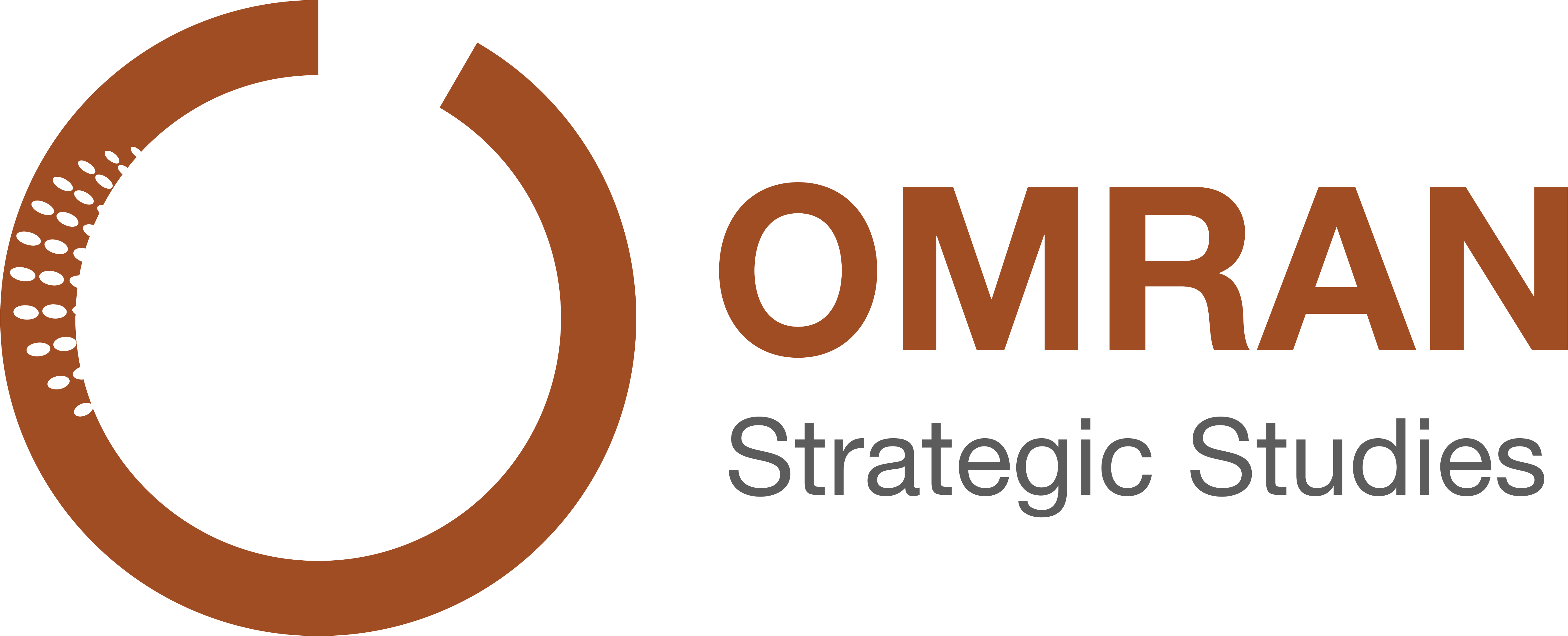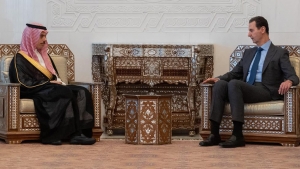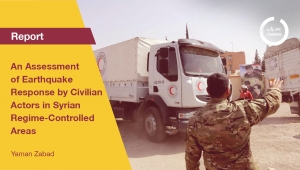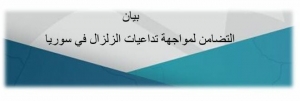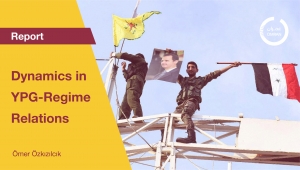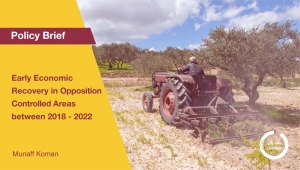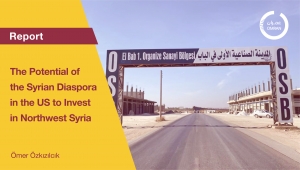Rateb
Monthly briefing on the events of the Syrian scene - April 2023
Executive Summary
This report provides an overview of the key events in Syria during April, focusing on political, security, and economic developments. One significant political event was the Arab rapprochement with the Assad regime, highlighted by the visit of the Saudi Foreign Minister to Damascus. This visit marked the end of a decade-long official boycott and was accompanied by the exchange of ambassadors between Damascus and Tunisia, as well as the reception of Assad's foreign minister in Egypt and Algeria. Despite these political developments, the shortage of essential goods and high prices remained major problems for the Syrian population. This issue was particularly pronounced during the month of Ramadan and Eid al-Fitr, with prices rising by 100% compared to the previous year. On the security front, there were no significant changes in the Syrian arena. Israeli airstrikes continued to target military and security sites associated with Iranian militias. Additionally, Ankara announced the killing of an ISIS leader.
Arab rapprochement with the Regime: “Swift Progress”
During April, the Syrian political scene revolved around the Arab rapprochement with the Assad regime. This included significant developments such as:
- Tunisia reopening its embassy in Damascus.
- The regime's Foreign Minister, Faisal Miqdad, visiting Egypt and Algeria.
- The Saudi foreign minister's visit to Damascus after a decade-long official boycott.
These visits were part of an Arab diplomatic effort led by Saudi Arabia, Jordan, and the United Arab Emirates to engage with the Assad regime. This engagement came with various Arab demands, including political reforms and the establishment of a safe environment for the return of refugees, but at the same time it became clear, that the Arab rapprochement with the Assad regime lacked a clear roadmap for achieving desired outcomes. The path of reconciliation with Turkey also faced obstacles as the regime insisted on the withdrawal of Turkish forces from Syrian territory as a condition for restoring relations. Ankara, however, refused to include this condition in the current agenda.Meanwhile, key figures within the Opposition maintained their opposition to normalizing relations with Assad. They held meetings with European ambassadors and envoys in Qatar, capitalizing on the Western discourse that emphasizes non-normalization until UN resolutions are implemented.The "Autonomous Administration" focused on sending messages to regional countries aligned with the Assad regime. These messages aim to showcase the administration's ability, as a local Syrian entity, to play influential roles in areas of common interest, such as counterterrorism, preventing drug exports, and facilitating the return of refugees. The messages include the following key points:
- Launching the "Peaceful Resolution to the Syrian Crisis" initiative, urging the "Damascus government" to take urgent actions to expedite a solution.
- The readiness of the forces of the Autonomous Administration to join the Syrian army, as stated by SDF commander Mazloum Abdi.
- The announcement of the Autonomous Administration's preparedness to receive Syrian refugees from Lebanon in coordination with the UN and the EU.
Security incidents: “Limited Impact”
In April, Israel kept on targeting locations with Iranian influence and control. These strikes focused on security and military sites in various regions, including Damascus and its surrounding, al-Suwayda, Daraa, Quneitra, and Homs.Meanwhile, the International Coalition assassinated a prominent ISIS leader, Khaled Eid Ahmed al-Jubouri in Idlib, al-Jabouri is from Iraq, and responsible for planning terrorist attacks in Europe. Turkish intelligence also reported the assassination of another ISIS leader, Abu al-Hussein al-Husseini al-Qurashi, in a military operation conducted in northwestern Syria.Daraa witnessed a series of assassinations resulting in the loss of 32 lives, with an additional 17 individuals losing their lives in separate security incidents. This highlights the ongoing state of security chaos that the Assad regime and its allies have been unable to resolve.
Shortage of basic materials and high prices
In the Regime-controlled areas issue of escalating commodities prices continued to burden the Syrian population, particularly during the month of Ramadan and Eid al-Fitr. Prices surged by 100% compared to the previous year's Ramadan. The situation was compounded by the Syrian pound's depreciation, reaching a rate of 8,250 SYP against the dollar, while the Central Bank's ability to intervene in the market declined. In April, the regime government implemented several decisions, including:
- Increasing prices and fees for transporting materials and goods via trucks.
- The Telecommunications and Post Regulatory Authority (TPRA) raised the fares for cellular services by 30% to 35%, and fixed telecommunications services by 35% to 50%.
- The regime's government set the purchase price of wheat at 2,300 SYP per kilo of wheat. However, the production cost is around 2,050 SYP, resulting in a narrow profit margin of only 150 SYP per kilo for farmers.
The depreciation of the Syrian pound in Autonomous Administration-controlled areas has had repercussions across various sectors. In the electricity sector, generator owners raised the prices of amperes to 8,000 SYP, even though the municipalities of Qamishli and al-Haskalah had set the price at 7,000 SYP per ampere. Additionally, the region is still experiencing a shortage of sugar, which led to a price increase. During this month, the Administration, under Russian supervision, reached an agreement with the regime concerning "drinking water and electricity." As per the agreement, the regime will supply the city of Manbij and its surrounding areas with drinking water from the Babiri station in Khafsa. In return, the Autonomous Administration will provide the regime with 30 megawatts of electricity per day from the Tishreen and Tabqa Dam, along with 50 oil tanks per day. In Opposition-controlled areas, the local council in the city of Azaz demanded a reduction in the price of kilowatts from the electricity company AK ENERGY. The company responded by reducing the value of electricity subscriptions starting from April 10. However, despite this adjustment, people and local councils continued to express their dissatisfaction as the new price remained high and not in line with living conditions. Regarding recovery projects in the region, the Trust Fund for the Reconstruction of Syria announced the delivery of 400 tons of fertilizer to two thousand vegetable farms and 850 tons of fertilizer to two thousand wheat farms.
Regional efforts to mitigate Feb-6 earthquake damage
The Qatar Fund for Development has announced an agreement with the Turkish Presidency of Disaster and Emergency Management (AFAD) to support the establishment of an integrated city in northern Syria. This city aims to accommodate 70,000 people. Additionally, the Qatar Development Organization and the United States Agency for International Development have signed a funding agreement to support the Syrian Civil Defense Organization's essential operations. The "salvation" government in Idlib has reduced the price of domestic gas cylinders by 90 cents (around 17 Turkish liras), bringing it down from $13.5 to $12.6. Idlib National Hospital is also planning to distribute free medicines intended for cancer patients. The conditions for cancer patients in northwestern Syria have worsened as Turkish hospitals stopped receiving them after the earthquake disaster on February 6. The Syrian Response Coordinators/ منسقو استجابة سوريةteam has issued the final report on the damage caused by the February 6 earthquake in Syria and Turkey. The report reveals that:
- Over 1.8 million people were affected in northwestern Syria, with 4,256 civilian casualties, around 12,000 injured, and 67 individuals still missing.
- The number of displaced people has reached 300,000, with more than 65% of them being children, women, and individuals with special needs.
- Economic losses from the earthquake are estimated at $1.95 billion, including damage to public and private sectors and other facilities.
- The earthquake also caused significant damage to educational institutions (433 schools), medical facilities (73), and housing units (136).
An Assessment of Earthquake Response by Civilian Actors in Syrian Regime-Controlled Areas
Introduction
Following the devastating earthquake that struck cities in southern Turkey and northern Syria on February 6th, 2023, the civil society in Syria has mobilized in both areas. This included regions under the control of the Syrian regime as well as Northwest Syria, which is under the Opposition's control.
In previous years, the civil society in areas controlled by the Opposition has been responsible for addressing urgent needs arising from various crises, such as winter campaigns, post-shelling recovery efforts, and other emergencies. However, in areas under the Syrian regime's control, the concept of "Emergency Response" is a relatively new development.
The purpose of this paper is to examine the response by civil society organizations to the recent earthquake in areas under the Syrian regime's control. It will investigate the level of support provided by the regime, as well as the goals of civil society response. This will involve monitoring and assessing the activities of various institutions and categorizing them based on their seniority, the type of work they do, and their geographic coverage. Additionally, the study will better dissect the role of the "Syrian Trust for Development"(1) rthrough their response(2)
Other Fronts of The Syrian Trust for Development (STD)
The Syrian Trust for Development (STD) was established in 2007 to coordinate civil society efforts in Syria and promote them to the international community. Following the February 6, 2023 earthquake, the organization has sought to redefine its role both internally and externally, partnering with several external entities to support local initiatives and organizations.
Even though STD is overseen by Asma al-Assad, it was able to form partnerships with prominent organizations such as the Norwegian Refugee Council(3) . and UNESCO(4)but it has been unable to generate substantial income for the regime from humanitarian aid funding, as the grants provided by the United Nations did not exceed $6 million during the years 2016-2017-2018.(5).
Activating (STD) became increasingly necessary after 2019, when the Caesar sanctions and successive Western sanctions against Syrian regime officials created financial urgency, so STD tried to become a back door to critical financial needs reflected by the earthquake disaster based on the civil actors that were active in the areas controlled by the Syrian regime.
The entities that participated in the emergency response have been categorized into unions, licensed organizations, Syrian initiatives created in response to the disaster, non-Syrian organizations and initiatives, and organizations affiliated with STD. There were around 134 Syrian and non-Syrian civil entities involved in the emergency response, and this estimate does not include official or foreign government delegations that visited the Syrian regime or provided direct aid to regime airports.
As shown in Figure (1), more than 45% of the organizations (Syrian and foreign) that participated in the earthquake response are linked to (STD) through a partnership or affiliation(6).At the same time, a good number of volunteers were mobilized to respond without being fully regulated by the regime, like its behavior with some religious groups in Damascus between 2006 and 2009, in order to ease the burden of relief work on it after failing to meet the relief needs of the poor classes in the capital.(7)
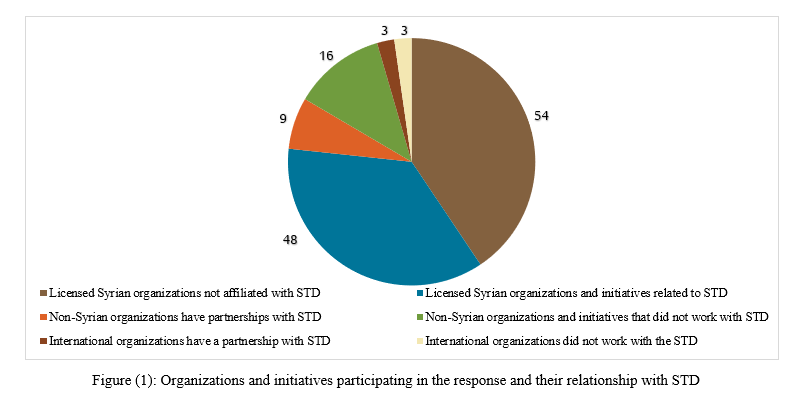
On the other hand, STD did not receive any direct support from international organizations or non-Syrian government support. Instead, STD collaborated with non-Syrian to provide aid. The organization also made efforts to publicize the delegations and international or civil aid they provided to earthquake victims(8) However, foreign organizations ignored STD on their media pages, Such as the Pakistani humanitarian organization and the Emirati Red Crescent.(9)
The Response and Its Quality
The earthquake struck several Syrian provinces, including Aleppo, Hama, Idlib, Tartous, and Latakia, with their countryside. The "Supreme Relief Committee" in the regime's government announced that:
- The number of affected families due to the earthquake reached 91,794.
- The number of buildings unsuitable for living reached 4,444 buildings, and 29,000 buildings can be used but require major reinforcements.
- The number of buildings suitable for use but need maintenance reached 30,000.
The number of buildings that got demolished due to their exposure to collapse reached 292., the number of deaths due to the earthquake reached 1,414 and 2,357 injuries.(10)
On March 3rd, 2023, the World Bank released a report estimating the material losses from the earthquake that struck four Syrian provinces at around 5.1 billion US dollars. However, Bashar al-Assad claimed that 50 billion US dollars were required to rehabilitate the affected areas (11) and that was a clear indication of the regime's exploitation of the earthquake disaster in order to benefit from the exemption from the US and Western sanctions relief that was issued after the earthquake.
During this period, civil society actors’ response to the earthquake varied in each province, as seen in Figure (2), which displays the number of organizations operating in each affected province under the control of the Syrian regime. Aleppo had 85 organizations, Latakia had 76, and Hama had 66. Most participating organizations in the emergency response were based in Damascus.

The entities engaged in the emergency response operate within different sectors, as shown in Figure (3), and many work in more than one sector. However, the variation in size of relief efforts delivere combined with the lack of ability to evaluate its volume due to the absence of reports from civil organizations about their work, number of beneficiaries, and selection mechanisms, is an indicator of weak transparency standards, making it impossible to assess the amount of aid provided and its impact.

The Syrian regime aimed to promote the image of civil society in areas under its control in an attempt to create alternative operational mechanisms for its official institutions, which were subject to sanctions from US and/or EU, or for some of the companies that funded them and surfaced after the outbreak of the Syrian uprising.Figure (4) displays the establishment dates of organizations and initiatives that participated in the recent emergency response. “The number of organizations and initiatives founded after 2011 is twice that of those established since the Ba'ath party took power in 1963.”
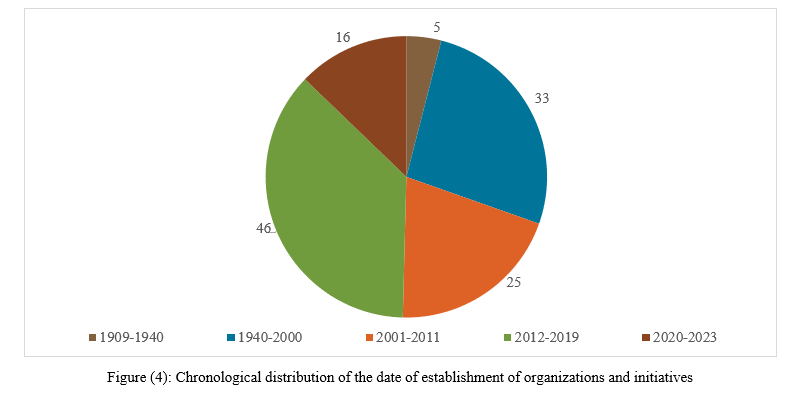
Although civil society activities and areas of operations, seems to have expanded in areas controlled by the Syrian Regime, it has not been successful in establishing significant partnerships across different affected areas by the earthquake in Syria, for several reasons, such as:
- Systematic flaws in the laws regulating civil society organizations.
- The regime's security philosophy, which restricts and monitors the work of many organizations seeking to align themselves with STD.
Despite the challenges faced by civil society in areas under the control of the Syrian Regime, they have managed to establish a few limited partnerships, primarily through the efforts of STD.
Conclusion
In summary, there has been a notable increase in the number of civil society actors, both Syrian and non-Syrian, responding to the earthquake in areas controlled by the regime. However, there is a lack of accurate data regarding the extent of their work, funding, outcomes, and challenges. Additionally, most organizations have not published reports detailing their activities, which has led to skepticism about the authenticity of the media coverage.
While civil society engagement is crucial in responding to humanitarian crises, the regulatory framework governing civil action, coupled with the regime's security-focused approach, meant that civil actors’ engagement is constantly scrutinized. Furthermore, the lack of clear coordination and integration methods, oversight mechanisms, and transparency has played into the regime's hands, especially concerning the Syrian Trust for Development, which it views as a politically exploitable tool. Despite the regime's attempts to showcase the effectiveness of civil society organizations in its regions to attract international support, no such support has materialized yet.
([1]) The Syrian Trust for Development (STD) is a non-profit organization based in Damascus, Syria. It was established in 2007 and is owned by Asma al-Assad. The stated goal of its founding was to promote sustainable development in Syria by providing financial grants and other forms of assistance for projects that support economic growth and improve the quality of life for Syrians. It became a major player after 2011.
(2)The survey was conducted based on the identifiers of organizations, initiatives, and unions, in addition to the pages STD, where a full table was prepared of 134 entities that participated in the emergency response to the earthquake, in addition to the spread of these associations, their work sectors, and their association with STD based on previous implemented projects.
(3) STD Facebook page 02/03/2023 https://bit.ly/3FwJvWH
(4)Prime Ministry website, the Syrian Trust for Development is an organization accredited by UNESCO for the next four years 12/22/2021 https://bit.ly/3YVQqiY
(5)The role of charitable work in the Syrian war: Non-governmental organizations sponsored by the regime and charities affiliated with armed groups, Robert Schuman Center for Postgraduate Studies at the European University Institute, Ayman al-Dasouki and Sinan Hatahet 07/06/2020 https://bit.ly/3LB0Amt
(6)Affiliation means the presence of the following indicators: 1- Exclusive financing by the Secretariat 2- Direct supervision.
(7)The Limits of “Authoritarian Modernization” in Syria: Private Social Security, Islamic Charities, and the Rise of the Zayd Group, International Journal of Middle Eastern Studies, Thomas Perret and Ketel Silvik, Issue 41 (2009) https://bit.ly/3mQavtO
(8) STD Facebook page about its partnerships with the Pakistani Humanitarian Organization 03/03/2023 https://bit.ly/3kM8pL1
(9)Look at the following:
- The Facebook page of the Pakistan Humanitarian Organization 03/03/2023 https://bit.ly/3JOKWma
- Emirates Red Crescent Facebook page 02/18/2023, https://bit.ly/3JuNsN1
(10)Deeb Sarhan: “What is the final outcome of the devastating earthquake in Syria?”, Qasioun, 3/4/2023, https://2u.pw/QHlhB2
(11) Al-Assad estimates the earthquake’s damage ten times the estimates of the “World Bank,” Enab Baladi, 3/16/2023, https://2u.pw/6Yeyc4
Statement Solidarity to Counter Repercussions of the Earthquake in Syria
10- February- 2023
The earthquake that struck southern Turkey, and northern and western Syria caused heavy casualties, exceeding thousands of dead and missing, and hundreds of thousands of displaced people, with massive destruction of infrastructure and deterioration of basic living conditions. This new shocking catastrophe exacerbated the suffering of all Syrian men and women, residents, internally displaced, or refugees, in a war-torn country that has been politically and socially fragmented and controlled by various military and security forces and dominated by conflict economies. It has become clear that the warring actors cannot meet the protracted challenges caused by the 12 years of the conflict, or cope with the earthquake's immeasurable effects. Those actors will generate further injustice and exclusion and increase the suffering of both those affected and survivors of the earthquake.
The Societal Role: Syrians have shown a high level of solidarity since the first hours of the disaster; they joined forces at home and abroad, expressing their unity in the face of the tragedies associated with the earthquake. Syrians, women and men, are in dire need of solidarity in the face of the earthquake and its direct and indirect ramifications through joint action in order to help those affected, identify priorities and options for intervention and mitigate the effects of the disaster. The priority is to coordinate and respond to reach the most affected individuals and communities and save their lives before it is too late.
Overcoming Conflict’s Polarizations: Efforts have been already made to create solidarity between civil institutions and community initiatives working in the civic space, they aim to open a new space for Syrian solidarity action, which is an urgent need to identify the sufferings and needs of Syrians, overcome the damage and help those affected, improve the effectiveness of interventions, share experiences and resources, and enhance the role of society in the potential interventions. Strengthening cross-division solidarity and overcoming political, regional, ethnic, religious, gender and other divisions that have deepened during the conflict require mobilizing the human, material and institutional resources in all regions through joint action to mitigate the damage and overcome the divisions of the conflict. Solidarity requires the advancement of civic action towards transparent and effective governance and accountability, a commitment to the ethics and principles of humanitarian work, human rights, dignity and freedoms, and an emphasis on justice and participation at all stages of activity.
The Humanitarian-Development-Response: In order to overcome the gaps and challenges associated with the relief response, it is necessary that the Syrian society takes the initiative in leading and organizing the response, producing evidence and field studies to underpin urgent interventions and make them available to all. It is also necessary to coordinate between the local communities, civic initiatives and research centres. In addition, it is essential to link relief interventions with development alternatives, as well as linking humanitarian interventions with dismantling the conflict causes and mechanisms to ensure that the effects of the disaster are overcome in a sustainable manner.
Effective International Solidarity: Despite the remarkable solidarity and cooperation of individuals and institutions at the international level, confronting the disaster requires a different role from the UN and international institutions. Humanitarian aid is insufficient without a safe space for work, fair access for all, and breaking the restrictions imposed by political and military forces. International support is crucial to overcome the catastrophe provided that the Syrian society is given a space to take the initiative in managing interventions -while focusing on commitment to interventions that are centered on the rights and freedoms of Syrians- and confronting the narrow political interests of the conflict forces by lifting restrictions on mobility and providing human and material aid across borders and regions.
Exerting Pressure on the Warring Parties: Pressure should be exerted on political and military local, regional and international forces to open internal and external conflict lines for humanitarian/development activity, to redirect military and security spending to confronting the disaster, to stop levying royalties, pillage, monopoly, and encroachment on aid and civil organizations and initiatives. The civil actors need to work and advocate to redistribute energy derivatives, food, housing, and decent living conditions to those affected by the disaster, and to put an end to hate speech and political exploitation of the suffering of Syrians.
This statement is a call for solidarity to overcome the ramifications of the catastrophic earthquake and dynamics of the Syrian war.
Signatory organizations Syrian Centre for Policy Research (SCPR) – OMRAN Center for Strategic Studies - Basmeh & Zeitooneh - Hand in Hand for Relief and Development - Baytna Syria - Multi Aid Programs (MAPs) - Ettijahat- Independent Culture - Musawa: Women’s Study Center for Equality - Local Development and Small Project Support (LDSPS).
The Syrian Regime Signals Legal and Military Shifts to the World
Since mid-2021, the Syrian regime has introduced a set of new policies targeting a number of vital sectors. These policies can be mostly observed in the legal and legislative sector, as well as with new appointments in the security and military fields—Syria’s most thriving branch ever since 2011. These changes, which have been kickstarted after the latest presidential elections in May 2021 and the formation of a new government in August, have been part of the regime’s new push to end its international isolation, while military operations were reduced to the minimum.
Legislative changes
The new laws introduced over the last year represent the regime’s attempts to get closer to the appearance of a modern state. It aims to facilitate a comeback to the international community by addressing matters it had ignored in the past years. Changes in legislations are listed chronologically as follows:
The Child Protection Act, Law No. (21) of 2021, issued in August, is the first of its kind in Syria. This law, according to the regime, aims to promote the state’s role—in both public and private institutions—in protecting children, providing care, and ensuring scientific, cultural, psychological, and social rehabilitation of all children.
By introducing this law, the regime tried to portray itself as the protector of children and their rights. According to this text, children are granted the right to education, and any child under 15 is prohibited from working. The law bans the use of children in media or publicity in a way that infringes their privacy. Additionally, children are not to be affiliated with political parties. The legal age for marriage is also fixed at 18.
The law outlaws recruiting or involving children in armed conflicts and any other related activities. In both criminal and civil terms, children cannot be held responsible for committing criminal acts; instead, they are considered victims in the eyes of this law. Children must also be protected from trafficking.
According to the law, the Syrian state has the duty to ensure necessary measures to grant children all their rights. However, there is a great disparity between statements made by the regime and the reality on the ground. A United Nations report states that in 2021, 46 children had been recruited and taken advantage of by pro-government militias. In addition, in 2021 as well, there were 48 recorded cases of children imprisoned by government forces, and 301 killed by Syrian government forces in opposition-held areas. This is without counting the 22,941 children killed by regime forces between 2011 and March 2022. Moreover, 6,358 children are still detained or forcibly disappeared in regime prisons.
The presidential decree abolishing the position of Grand Mufti of the Republic: In November 2021, Bashar al-Assad issued Legislative Decree No. (28) to strengthen the Council of Islamic Jurisprudence and expand its competencies. The decree amended articles of Law No. (31) of 2018 which regulated the work of the ministry of religious endowments and abolished the positions of Grand Mufti of the Republic and the governorates’ local muftis.
With this decree, the Grand Mufti’s role is no longer the purview of one person. It has instead become the duty of the Council on Islamic Jurisprudence, headed by the minister of religious endowments and composed of 44 members representing all Muslim sects and the country’s Christian communities.
This decree is undoubtedly a shift in the regime’s religious policy and deprives Sunnis from a mufti position, implicitly annulling their majority. “This shift does not suggest that Assad’s regime is giving up its harsh centralized grip or embarking on a new secular approach. The regime is rather adapting to challenges generated by the Syrian revolution. It is trying to keep up with a transforming religious elite and its relation with the general public. What can be observed here is an attempt by the regime to tackle the crisis in a different way.”
This decree incorporates members of the Shia community to the jurisprudence domain, a step signaling closer ties to Iran. With this decree, Iran has been ensured a formal access to the Syrian religious sphere.
Anti-Torture Act: Law No. (16) of 2022 was passed in March and criminalizes torture in few articles and brief details. Sentences for those found guilty of torture range from three years of imprisonment up to the death penalty. Life sentence is applied in cases involving torture against a child or a person with a disability, or when causing permanent impairment to the victim.
This law has no precedence in Syria, which marks a change, at least in theory. Nonetheless, it contains important gaps and its exact application remains unclear. For instance, members of the armed forces who are accused of torture are not mentioned by the law. Resting on their impunity, it is prohibited to file a lawsuit against them without the permission of the armed forces’s general command. The same applies to members of agencies such as General Intelligence, as well as the Political Security Unit and the Internal Security Forces—both linked to the Ministry of Interior. Similarly, members of the Customs Department, an organ of the Ministry of Finance, enjoy the same level of impunity.
In addition, the law does not specify any regulatory frameworks: it falls short of naming entities and spaces that will be scrutinized. For instance, it does not cover prisons, where ten thousand prisoners were, and still are, tortured.
It is no coincidence that this law has been issued after the Caesar Report was released, documenting systematic torture and killings inside regime-run prisons. At least 14,449 detainees—including 174 children and 74 women—were documented to have gotten murdered by the Syrian regime forces in prisons between 2011 and March 2022, with no legal consequences.
Penal Code: In March 2022, Law No. (15) was passed, introducing amendments to the Syrian Penal Code. The new law eliminates permanent and temporary hard labor penalties, stipulated in all other legislations, and replaces them with prison time or a life sentence. Another amendment raises the fines for crimes, ranging between 25,000 to 6 million Syrian pounds ($25 – $1,185), depending on the nature of crime.
The new law also modified Articles 285 and 286 of the Penal Code, punishing those who “infringe the national identity or provoke racial and sectarian strife” with temporary imprisonment. The same applies for anyone who disseminates “fake or exaggerated news to create a sense of despair or insecurity within the society.” Syrians who call for dividing or conceding sovereign territories—in any written or verbal form—face at least one year of imprisonment.
The Syrian regime has repeatedly resorted to both articles, particularly Article 285 which criminalizes those who “weaken national sentiment.” These articles have become the fundamental legal basis for bringing charges against protestors who have taken part in the revolutionary movement since 2011. All of those incarcerated by the Syrian regime face outright arbitrary charges. Every time an amnesty decree is issued, these two provisions were incorporated while other articles were excluded.
Cybercrime Law: The Cybercrime Law No. (20) of 2022 was passed in April and was presented as an alternative to the 2012 law combating cybercrimes. The new law raised the number of penal offenses from nine to 21.
The law mainly expands privacy-related crimes and extends prison terms. The 2022 law raises the amount of financial penalties, taking into consideration the depreciation of the Syrian currency. For example, in cases of unauthorized access or use of data, the 2012 law stipulated a sentence of 3 months to 2 years, which turned into 1 to 3 years with the new law. Equally, fines were raised from 100,000 – 500,000 Syrian pounds ($20 – $100) to 700,000 – 1 million Syrian pounds ($140 – $200). In addition, the law added more penal offenses to crimes related to the constitution and undermining the state’s prestige or financial situation.
After passing the law, the Ministry of Interior started restructuring and rebuilding the Cybercrime Combating Branch Unit and announced that a number of people were detained on various charges under the 2022 law.
The way the law has been applied in Syria is alarming. The regime has used it as an additional tool to silence Syrians who live in regime-controlled areas and to prosecute those who fled. In other words, the regime has succeeded in re-legitimizing the state of emergency in a new and implicit fashion.
Amnesty Decrees: In January 2022, Assad issued Legislative Decree No. (3), granting a general amnesty for those who have deserted, whether volunteers or those who were completing their compulsory military service. For those who deserted domestically, they must turn themselves in within three months, and those abroad must surrender themselves in four months, at the latest.
This decree was meant to facilitate new security settlements in the regions of Raqqa, Deir Ezzor, Aleppo, and the Damascus countryside, so that the regime can benefit from those who had previously defected from the army and have them return to service. At the same time, the regime wanted to send a message to military rebels abroad, especially those in Turkey, following the closure of a camp in the Turkish province of Hatay.
In April 2022, Assad passed Legislative Decree No. (7), which grants general amnesty for “terrorism-related crimes’” that did not cause any death, as stipulated in the Counter-terrorism Law and the Penal Code and its amendments. At the beginning, the decree drew regional and international attention, however, loopholes were soon detected, which allowed the regime to carry on with the criminal policy it had been pursuing against the Syrian people since 2011.
Since 2011, there have been 23 amnesty decrees, and yet, there are still about 132,000 detainees inside the regime prisons. Only 539 prisoners were released after the latest amnesty decree, all the while 300 individuals were arrested by regime forces between May and August 2022—28 of whom were later set free.
The Assad regime has been using these new legislations to put an end to its isolation imposed by the international community since 2011. The Syrian regime had depended on Russia in the past to break its isolation in the international scene, but it can no longer do so, as Russia has become even more isolated than Syria following its war in Ukraine. The legislative efforts observed in the past year have been issued alongside other noteworthy appointments and changes in the military and security fields.
The new era of appointments
There have been some notable changes in some of the appointments in the military and security fields. On April 28, 2022, Assad appointed Major General Ali Mahmoud Abbas, a Sunni from the Damascus countryside, as the new Minister of Defense. His predecessor was Ali Abdullah Ayoub, an Alawite who has occupied this position since early 2018.
Two days after this announcement, Assad appointed on April 30 artillery officer Major General Abdul Karim Ibrahim, an Alawi from Tartous, as Chief of General Staff of the Army and Armed Forces. This position had been left vacant for four years, since early 2018, and was mandated by the Russian operations center in Damascus. Giving this post back to a Syrian official was viewed as the Syrian regime reclaiming the office away from Russia, busy with its war in Ukraine.
These new appointments were controversially received and analyzed. Indeed, they mark a change from previous military hierarchical traditions in Syria: in the past, these top positions were filled by officers with higher ranks—Lieutenant Generals, not Major Generals. The newly-appointed officials were not among the oldest officers with this rank, and this once again was at odds with the military hierarchical order, applied in the Syrian army. It was only after their appointment that both Abbas and Ibrahim were promoted to the rank of Lieutenant General. The number of Lieutenant Generals in the army does not exceed 25, when there are thousands of Major Generals. Yet, being promoted to the rank of Major General is considered a source of pride and reflects close connections with the regime. The decisive criterion for promotion is primarily determined by the degree of loyalty to the leadership, irrespective of professional performance.
There has been no violation to the Military Service Law with these appointments. The rule is that Major Generals decide by free choice who is to be promoted to Lieutenant General. The authority to assign senior posts lies in the hands of “the President of the Republic” and “is enforced by decree and informed by proposal from the Commander in Chief,” both positions held by Assad himself.
These appointments broke a set of military norms, partially because both the current Minister of Defense and Chief of General Staff had never led military operations within the framework of combat units, such as commanding divisions or corps. The Chief of Staff position had been traditionally controlled by someone specialized in ground forces or tanks, not artillery, as in the case of Lieutenant General Ibrahim. Moreover, choosing a Sunni defense minister disrupts—albeit on a limited scale—the Alawi sect’s domination inside the military institution. A study published in 2020 indicated that the 40 most senior military and security officeholders in Syria were Alawis.
Minister of Defense Lieutenant General Ali Abbas served for a long period as a trainer at the Armored Corps College and the High Military Academy. He attended military training abroad, in Pakistan, Sweden, the Netherlands, and Great Britain. The most noteworthy of these training programs was one on reforming the security sector in post-conflict countries, which he attended in the United Kingdom in 2006.
A few days after these appointments, the Assad regime’s tactic became clearer. Neither the Minister of Defense nor the Chief of Staff had been targeted by western sanctions, unlike their predecessors. They are not well known among Syrians, and have yet to be associated with war crimes. Furthermore, the military training courses in Western countries that the minister of defense had taken part to are not common among the military leadership, considering that most take part in military training in Russia and China.
As for the security sector, there have been some changes and promotions at the senior leadership levels in the country’s security services. For instance, this March, a number of intelligence service officers were reassigned, and in early July 2022, others were promoted to higher ranks and positions.
Several security services leaders and officers have been cast aside, while others were promoted and are now the new faces of these agencies with more changes expected: there are speculations that the directors of the Military, Air Force, as well as General Intelligence services are to be replaced in the next few months. The head of the Political Security Division will probably be reassigned to command the General Intelligence Directorate.
Addressing the lower levels in the military hierarchy, Assad issued an administrative order ending the retention and recall of officers and reserve officer candidates enrolled in the compulsory military service. Enlisted officers and officer candidates, who are enrolled in compulsory service are to be demobilized, and non-commissioned officers and reserve personnel must not be retained or recalled anymore. The objective of these decisions is to encourage university graduates, such as doctors and engineers, to stay in their country. Ultimately, the regime seeks to decelerate the very costly waves of migration.
Cosmetic restructuring for the international community
Lately, the Syrian regime has passed an array of legislations to convey the message that it was adopting new policies in compliance with human rights. In the same vein, the regime has organized training courses on international humanitarian law for defense ministry officers. In parallel, government officials have made recurring announcements highlighting Syria’s role as a pioneer in this field, by showcasing capacity-building and awareness-raising activities. The apparent discrepancy between those announcements and the latest policies, and what is really happening on the ground, is astounding. Some of the adopted laws are compatible with the international standards on the surface but when examined closely, it becomes evident that they merely serve as cover-up for the regime’s past and current actions.
In the military and security sector, the regime is trying to initiate a tactical restructuring of upper echelons of its leadership before gradually tackling the more junior levels in the chain of commands. The latest appointments put forward new officers, portrayed by the regime as devoid of guilt and untainted by the blood of the Syrian people. It is expected that, in the next few months, a series of changes will be carried out that will impact key positions in the military institution, and possibly laws, as the regime seeks to achieve more conformity with its actual policies.
The regime has embarked on restructuring the entire state over the post-war phase, despite the war not having ended yet. New policies will cover a larger spectrum of vital sectors. The Russian and Iranian allies are expected to be granted a share, their interests and goals will be taken into account in exchange for securing the continuation of their services to the regime.
Simultaneously, the regime aims to ease the pressure on two issues—refugees and sanctions—with the international community, and is hoping to benefit from setting the country on the path to reconstruction to help support its crumbling economy.
What the Assad regime has been showcasing this past year is that it wants to propose and lead cosmetic reforms, while excluding meaningful political change, expecting to be treated like a victor. The regime seems to be completely convinced that these policies will wipe away its years of destruction and bloodshed and will restore its image to the world. The regime would like the world forget that it used heavy and internationally-prohibited weapons, torture, blockade, and starvation against its own people.
The international community and concerned countries must assume the responsibility of holding the regime accountable to binding international resolutions and enforcing a political solution, which establishes civil peace and instates transitional justice. They have to be reminded that the fundamental dilemma in Syria is not a matter of laws or institutions. The dilemma lies inherently in the ruling regime, which manipulates the state for its self-interest.
Dynamics in YPG-Regime Relations
While facing a potential new military operation by the Turkish Armed Forces and the Syrian National Army (SNA) in northern Syria, the general commander of the YPG-dominated Syrian Democratic Forces (SDF) stated in his interview with Asharq al-Awsat:
“We are not opposed to the SDF becoming part of the defense organization of the Syrian army. We have conditions, however. We boast over 100,000 fighters, who have spent the past ten years in combat. They need a constitutional and legal resolution. The SDF must have a role and specific distinction in the military. We are in agreement over general issues, but the problems lie in the details.”
He also stated; “I want dispatch a delegation and go to Damscus when the conditions fora solution are available. I want my trip to Damascus to help in reaching a peaceful solution to the current crisis. ”This statement outlines the current relationship between the Assad regime and the YPG. To understand this relationship and how a potentially new military operation may impact it, this report explores the dynamics of the relationship with focusing on the main dynamics that are related to a Turkish-Syrian military operation.
The first dynamic in the YPG-regime relationship is the concept of a common enemy. For both actors, Turkey and the Syrian opposition are perceived as enemies. However, the YPG’s and the regime’s perspectives oppose one another. The YPG perceives Turkey as an existential threat and sees the Syrian opposition as an actor that enables and facilitates Turkish military operations against the YPG. The Assad regime perceives the Syrian opposition as an existential threat and Turkey as an actor that enables the continuing presence and territorial control of the Syrian opposition. But, since 2016 during Operation Euphrates Shield, there was growing cooperation between the YPG and the Assad regime. Both YPG and the regime forces worked together against Turkey and the current situation resulting in YPG-regime signing an agreement in 2019. During this time, the Assad regime protected the YPG along the frontlines with the Turkish Armed Forces and SNA. Furthermore, in the past, the Assad regime handed over predominantly Kurdish territories to YPG as part of their cooperation in capturing Tal Rifaat and their joint fighting to besiege Aleppo city.
In looking at the second dynamic, the American military presence in Syria negatively influenced the YPG-regime relationship due to their support for the YPG. The US enabled the YPG to control vast territories and altered the balance of power between these two actors. The Assad regime and its supporters, including Iran and Russia did not want the US to remain in Syria. Moreover, there is a difference in ideology between the old and new generations within the PKK – the YPG’s main branch – as it relates to its international relationships. While the old generation values historic partners like the Assad regime, the new generation places its trust in its partnership with the US.
Interdependency is the last main dynamic in the YPG-regime relationship. The YPG and the Assad regime both have territorial control that relies on one another to cooperate. For example, the regime's territorial control in Qamishli and Hasakah is surrounded by the YPG and requires YPG cooperation. Similarly, YPG’s presence in Tal Rifaat and the Shaikh Maqsoud neighborhood in Aleppo city is dependent on the cooperation and protection of the regime that surrounds those areas. Since 2019, the Assad regime deployed army soldiers to the frontlines alongside the Turkish Armed Forces and SNA to function as protection to and from the YPG. This is due to the regime units being located in areas that are far away from regime-held territories where if a war broke out or the regime decided to withdraw their forces, then the YPG could have the ability to target and eliminate these units before the possibility of support arrives. Thus, this delineates the interdependency these two parties have with each other with the regime’s ability to provide YPG with the protection requested while also ensuring their weak points are exposed to minimal dangers.
In looking at the prospects of the YPG-regime relationship, the Assad regime has stated that it wants to go back to how things were in 2010, but with a ‘controllable population.’ It would require the regime to either assert full authority or accept some level of autonomy under the Russian reconciliation agreement model. On the other hand, the PKK’s new generation wants to establish an autonomous region in Syria and achieve international legitimacy via the US with the possibility of engaging in deals on the behalf of Syrian between the US and Russia. With that, the old generation believes that going through Damascus could result in international legitimacy, and would be more realistic as they would gain more legal standing and recognition on a local/national level.
Based on this examination, the report provides four different options for a Turkish-Syrian military operation against the YPG that may alter the YPG-regime relationship:
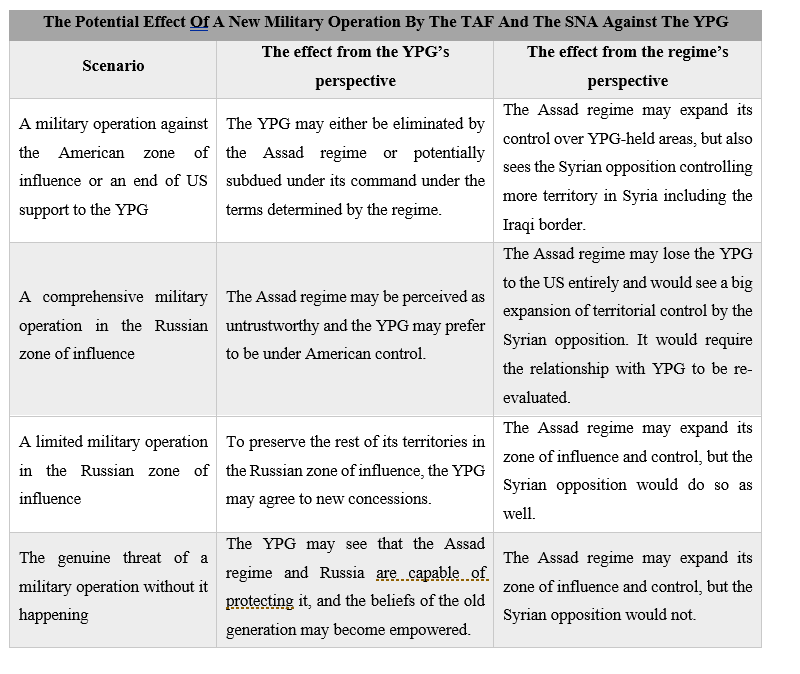
Salary Increases A Syrian Regime Policy Driving the Militarization of Society
Executive summary
- There is a prevailing pattern in salary increase process in syria along two main trends: Pricees of subsidized basic goods are increased by the regime’s government and soon after the head of the regime increases salaries, or vice versa, so that when salaries are increased by the head of the regime, then the government increases the prices of goods. In both cases the price of basic goods or salary increases happen within a very short time frame.
- Salaries reached their peak against the dollar in April 2011, before shrinking against it despite the successive increases in salaries. Today, salaries have reached lowest levels against the dollar since 2000.
- Salary increases were decided in equal proportion between the civil and military sectors until 2018 when Bashar al-Assad exclusively increased the salaries of army soldiers several times, while civilian salaries were not increased.
- Salaries are shrinking compared to the cost of living, as the minimum salary of 92,970 Syrian Pound is barely enough to cover expenses three days a month due to the deteriorating economic conditions in the country.
- Salary values denominated in dollars indicate a clear impact of the Lebanese banking crisis that began in 2019. This crisis was reflected in the depreciation of the value of the Syrian Pound against the dollar, and thus the value of salaries.
- The salary increase policy is one of the leading factors in the further militarization of society, by pushing young people to join the military or join militias and become mercenaries operating both inside and outside the borders of the country. This became an additional factor driving migration.
- The salary increase policy was adopted by the regime because it needed to motivate large groups of people to join official military institutions or militias. That is done by ensuring that the salary of the lowest ranking soldier in the military sector is greater than the salary of the highest income earners in the public sector.
Introduction
The problem of syria's public sector salaries, both civilian and military, is one of the chronic problems with historical roots extending back half a century. During the era of Hafez al-Assad, public sector employees experienced long consecutive years of deterioration of the value of their salaries as a result of the government’s economic policies, which continued into the era of Bashar al-Assad. This was despite his "attempts" to improve the living conditions of public sector employees at the expense of supporting other sectors such as agriculture and industry.
The difference between the salaries of civilians and the military personnel was of little importance, as the overall goal was to pay attention to the salaries of the public sector as a whole, including the military. However, developments since 2011, have shed light on the various aspects of the state, including how it disperses salaries. However, until now the information has not yet been properly detailed nor has a proper comparison that accurately assesses the differences in civilian and military salary increases in Syria been attempted.
Civilian public sector salaries are determined based on the state’s basic labor system(1). while military salaries are determined based on the Military Service Law for army soldiers(2),and the Internal Security Forces Service Law for members of the Internal Security Forces. Their executive instructions are issued by the Commander-in-Chief for the army and armed forces(3).
Historically, salary increases were issued by legislative decrees from the head of the regime during both the eras of Hafez and Bashar al-Assad. Salary increases have never been issued by the relevant state institutions; nor have there ever been any successful calls or pressures to increase salaries; neither the parliament nor the trade unions have any role since they were under direct command of Hafez al-Assad in the 80’s.
Salary increases have always been associated with an increase in the prices of basic goods; the prices of which are set by the government. These increases also included an increase in equal proportions in both the civilian and military sectors. As for the increases that took place after 2011, they came as a result of the increase in inflation and the decrease in the exchange rate of the Syrian Pound. The latter were accompanied by steady increases in the prices of basic goods in light of the deteriorating living conditions.
By 2018, military salaries were raised exclusively without any relation to increases to civilians in the public sector. In some cases, only certain groups of military personnel received raises while others were excluded. In addition, a pay gap started to appear in favor of military personnel over the Internal Security Forces even though by law they had an equal salary scale. The Internal Security Forces’ suspicions were not in vain since a legislative decree contained in Article 87 of the Military Service Law annulled the current salary scale and replaced it with a new scale that includes higher salaries without being determined by a specific percentage.
This paper assesses all public sector salaries in Syria starting in 1994, the last year in which salaries were increased by Hafez al-Assad, until 2022. The paper analyzes the trends of increases in general to detect patterns in the policy approaches of the regime regarding salary increases between the civilian and military sectors; to provide a comparison of civilian and the military salaries, find their values and what they are equivalent to in dollars according to the central bank and the black-market rates, as well as the value of income taxes imposed on them. The paper provides an interactive tool that helps make comparisons between different salary categories in the Syrian Pound and the US dollar, through the use of quantitative analysis tool, relying on official sources and mathematical equations to reach the value of salaries and ensure their validity(4).
Salary Increases Since 1994
It is customary in Syria for public salaries to be raised biennially, at a rate of 25%, while the inflation rate exceeded 30% annually - before 2011. Thus, workers and employees lose 17% of the value of their salaries annually as a result of the decline in the purchasing power of the Syrian Pound(5). The last increase in salaries during the era of Hafez al-Assad was executed through Legislative Decree No. 3 of 1994 (6). There were no more increases for six years until after the succession of power by Bashar al-Assad in 2000. By that time salaries steadily eroded, and their proportion in the national GDP decreased. The state sought to stabilize salaries and wages through a clear policy to reduce the volume of aggregate demand on the one hand; and to reduce costs through a policy of cheap wages on the other hand.
Less than two months after the succession of power, Bashar al-Assad issued the first salary increase since 1994, in an attempt to send a clear message that "economic recovery is near and that the state of economic stagnation from 1995-2000 has ended". However, the salary increase policy remained the same as before, salaries were increased approximately every two years, except for the period between 1994-2000. During the period between 2000 and 2010, 7 legislative decrees related to salaries were issued. Some of the increases included the entire sector of state workers; while other increases were specific to the military - as explicit increases - such as amending their salary schedule, or a special case like re-working at the rank of Candidate and 1st Candidate. (Murashah)
On the other hand, there were a greater number of legislative decrees related to salaries during the period between 2011-2022. 14 legislative decrees have been issued since March 2011. some of which included exclusive increases for the military. The period after 2011 witnessed double the number of legislative decrees related to salaries compared to the previous period; in an attempt by the regime to bridge and repair the gap between the price of the Syrian Pound and the US Dollar. The following table shows the referenced legislative decrees and percentages of salary increases from 2000 to 2022(7):
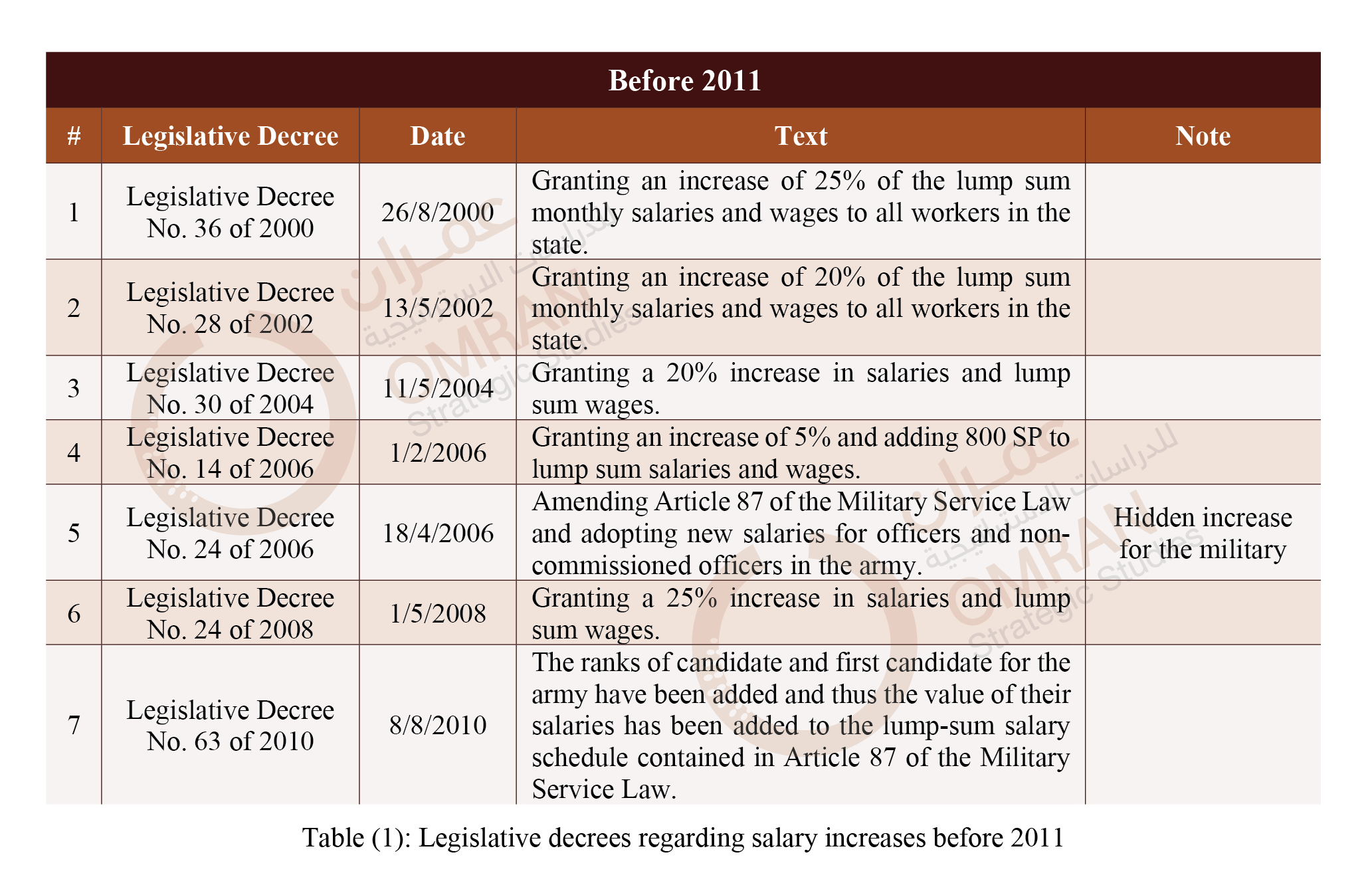

A Reading of Salary Increases Methods and its Effects
The regime used a method of indirect taxation to finance the increase in salaries and wages. Taxes on petroleum products, cement fertilizers, and mineral oils are increased under a pretext of “price differences” As aresult, the price of basic goods and services. increases and become less competitive in domestic and regional markets(10) .
This general pattern in the increase of salaries and wages closely coincides with a rise in the price of basic goods, an economic pattern prevailing for decades. However the rising price of basic goods and services is not always accompanied by an increase in salaries and wages, as the regime's government may raise the price of basic materials several times before salaries and wages are increased. This indicates “ adeep economic flaw” in the state management of the industrial and manufacturing sector. These unrealistic increases attempt to control prices, and encourage inflation as well. The following are salary increases that coincided with a rise in the price of basic goods: 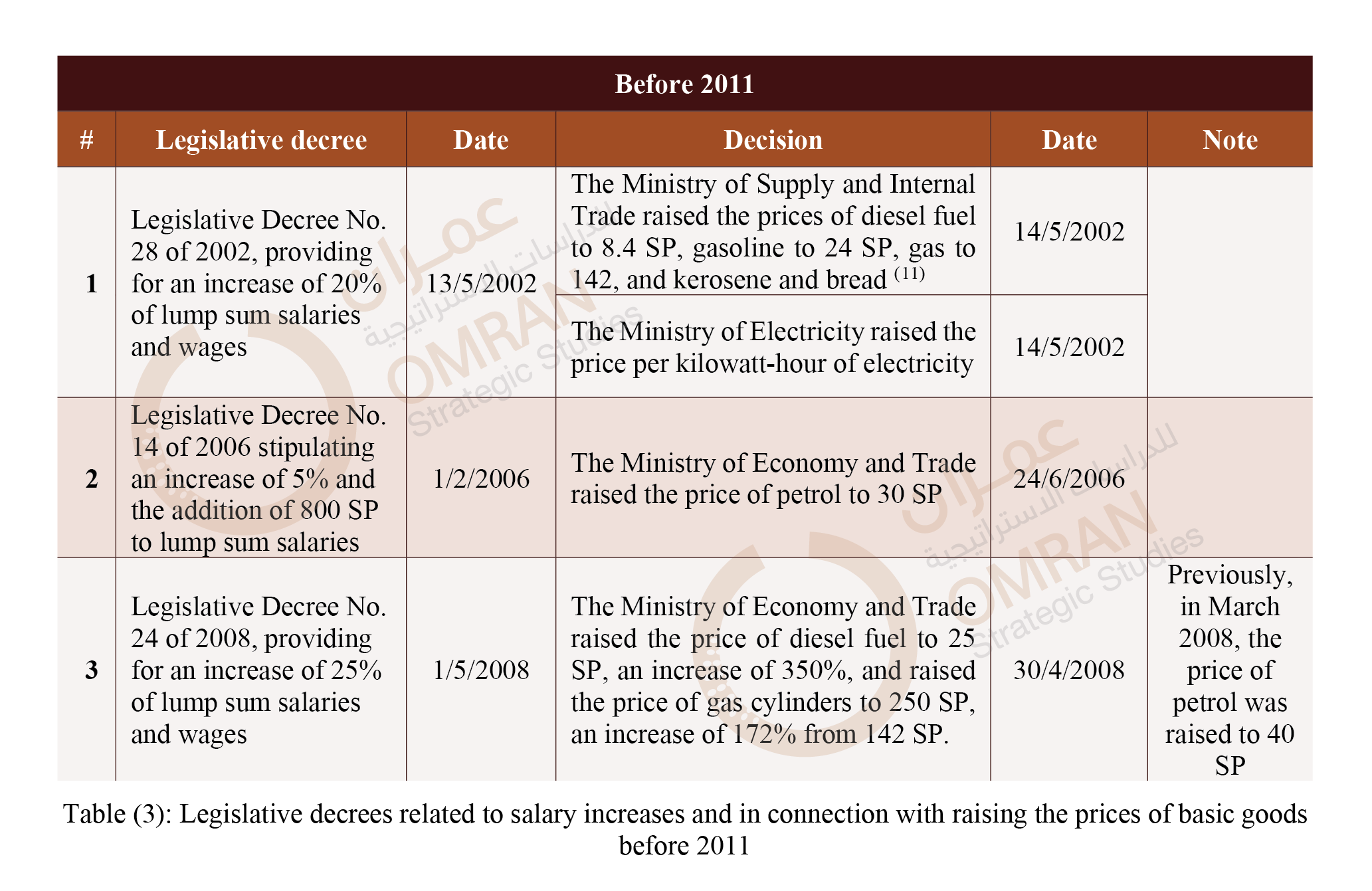
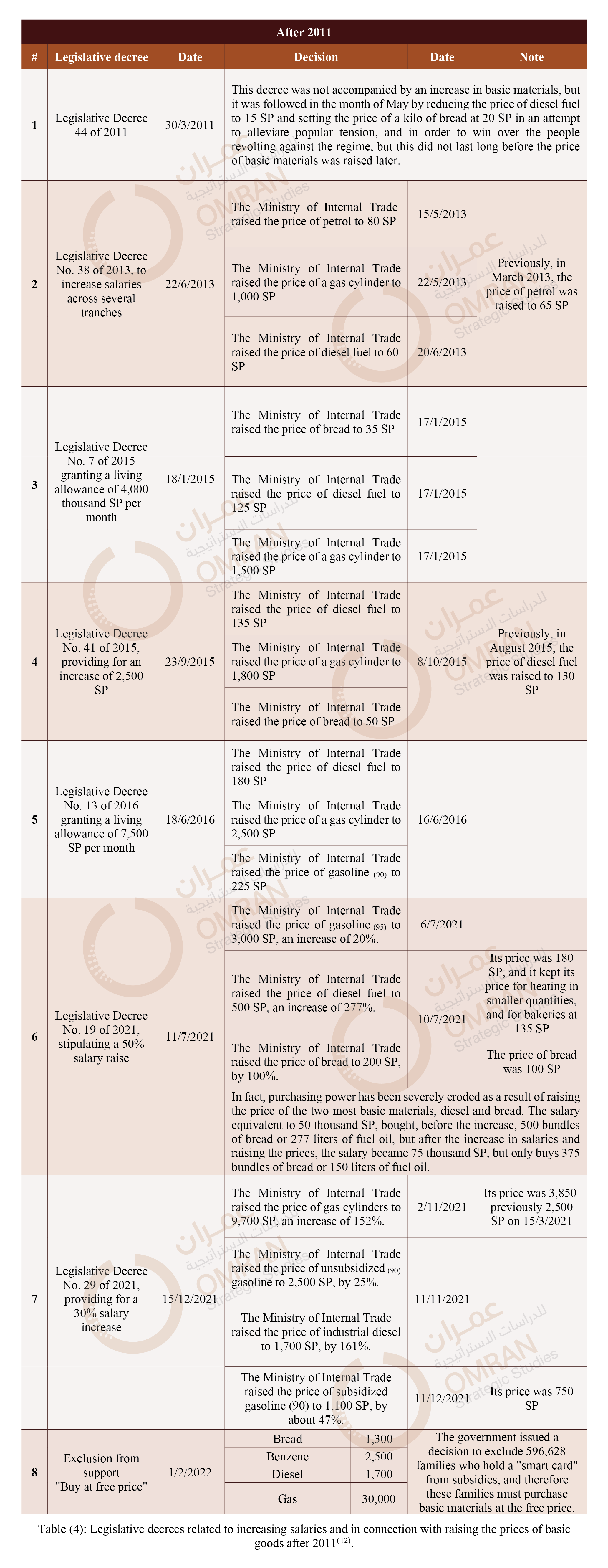
Comparing Civilian and Military Salary Scales
2018 was the first time a major change in the balance of salary increases appeared.between civilian and military public employees For the first time a legislative decree was issued including an explicit increase in the salaries of army soldiers excluded other public sector employees, including the Internal Security Forces.(police) Those increases came as a reward for the military’s efforts in preventing the fall of the regime in the face of the revolution. It was also an attempt to equate the salaries of the military to the salaries granted by militias to its members. Making a comparison between salaries and privileges of different armed factions in the state pushed society further towards militarization and encouraged civilians to join militias or the military institution (13). People preferred salaries granted by militias because they are greater than those officially granted in the state military institution. The salaries of the latter are greater than those of the civil sector, noting that there are official and unofficial privileges granted to members of the army, armed forces, and militia members that increase their total monthly income. It is a common misconception that the exclusive salary increases for military personnel in 2018 was a result of a Russian request, but instead stems from the regime’s need to militarize society. (See the appendix for the salaries of employees in the state including public and military sectors; and the internal security forces in the period between 1994 - 2022)
The comparison is between civilian and military personnel at entry- level pay scale and between the highest category among a civilian employee that hold a Ph.D degree and the starting scale of military personnel, (soldier).(14)The reasons for this comparison are due to two things: The aforementioned salaries are the start-up salaries, i.e., the salary of a Ph.D degree holder cannot be compared with the salary of a Captain ranking in the army, because a captain has 10 years of experience in public service. The differences between the salaries of these two categories are limited, however, there is a preponderance of military salaries over civilians of the same entry level scale(15).
A) Based on the Syrian Pound
It is noted that the gap in Syrian Pound between entry-level salaries of a soldier(rank: private) and a civilian holding a Ph.D degree has declined even further after 2011 until it became very small following Legislative Decree No. 8 of 2018. The percentage of the difference between the salaries in both categories in 2000 was 236% in favor of a civilian whth a Ph.D degree holder’s salary. This percentage fell to 178.9% in 2011, and reached 1.9% in 2022. This is assumes counting gross salaries before income tax is calculated.
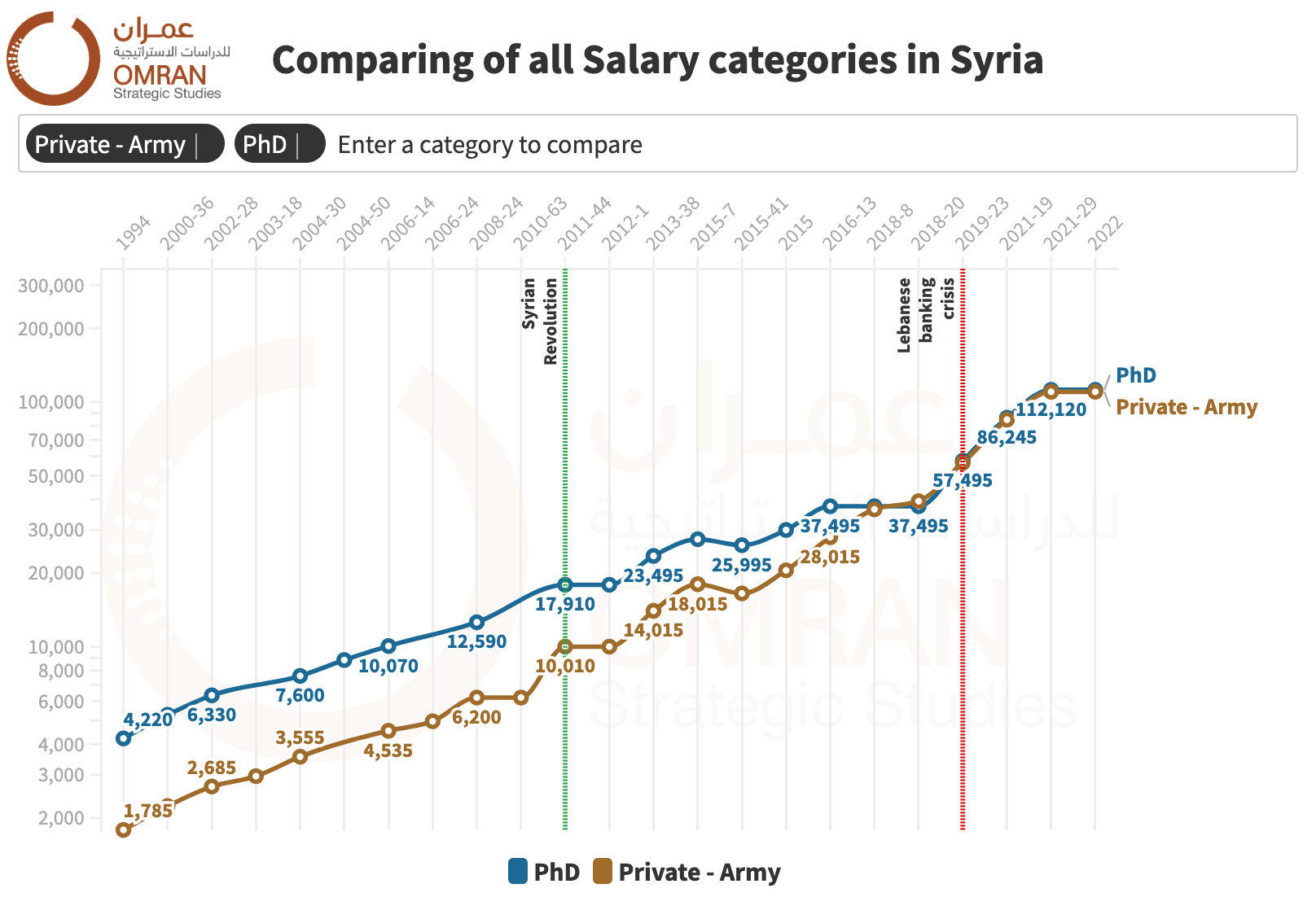
Figure (1): Comparison of salaries according to the Syrian pound for both doctoral and soldier ranks
B) Based on the US Dollar
prices of goods and services are often indexed on the US dollar and converted to syrian pound at the time of contracting . salaries reached their peak value in US dollars by the end of March 2011, after the issuance of Legislative Decree No. 44 of 2011, coinciding with the beginning of the Syrian revolution. In the meantime, the price of the dollar was equal to 47 SP according to the official exchange rate and 52 SP according to the black-market price(16). Later, with the declining value of the Syrian Pound, the salary value against the dollar gradually declined, as the successive increases in salaries from March 2011 to 2022 could not prevent this decline or even flatten its loss in value against the US dollar at the very least. It is also noted that the Lebanese financial crisis in 2019 affected the SP, which led to a further decline in the value of salaries on the basis of the dollar.Starting salaries for Ph.D holders, when measured in dollars between 2000 and 2022, shrank by a very large percentage, approximately 360.8%. While the salary of a soldier witnessed only a 156.3% decline in starting salaries during the same period due to the consecutive increases of exclusively military salaries.
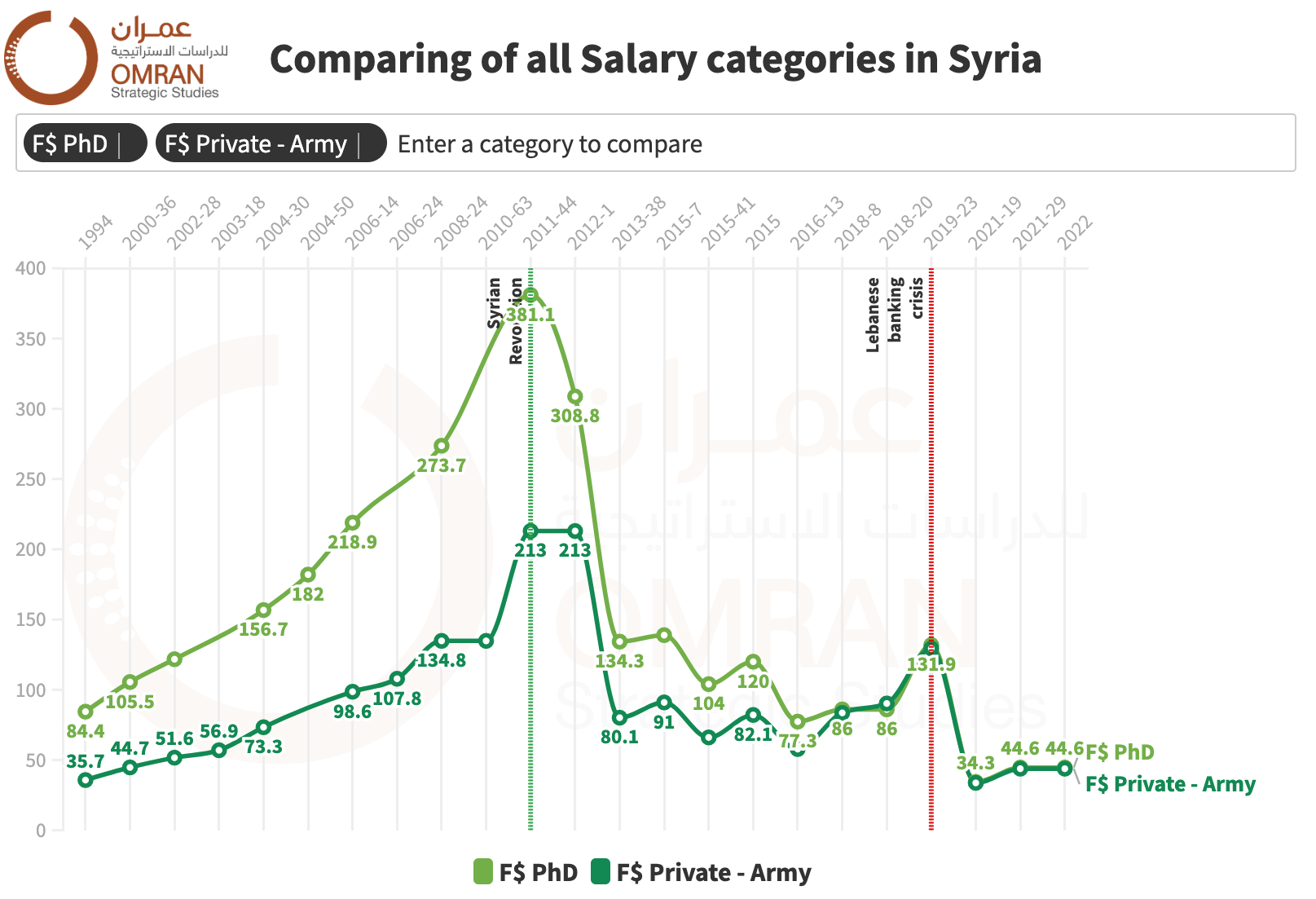
Figure (2): Salaries are denominated in dollars, according to the official rate from the Central Bank
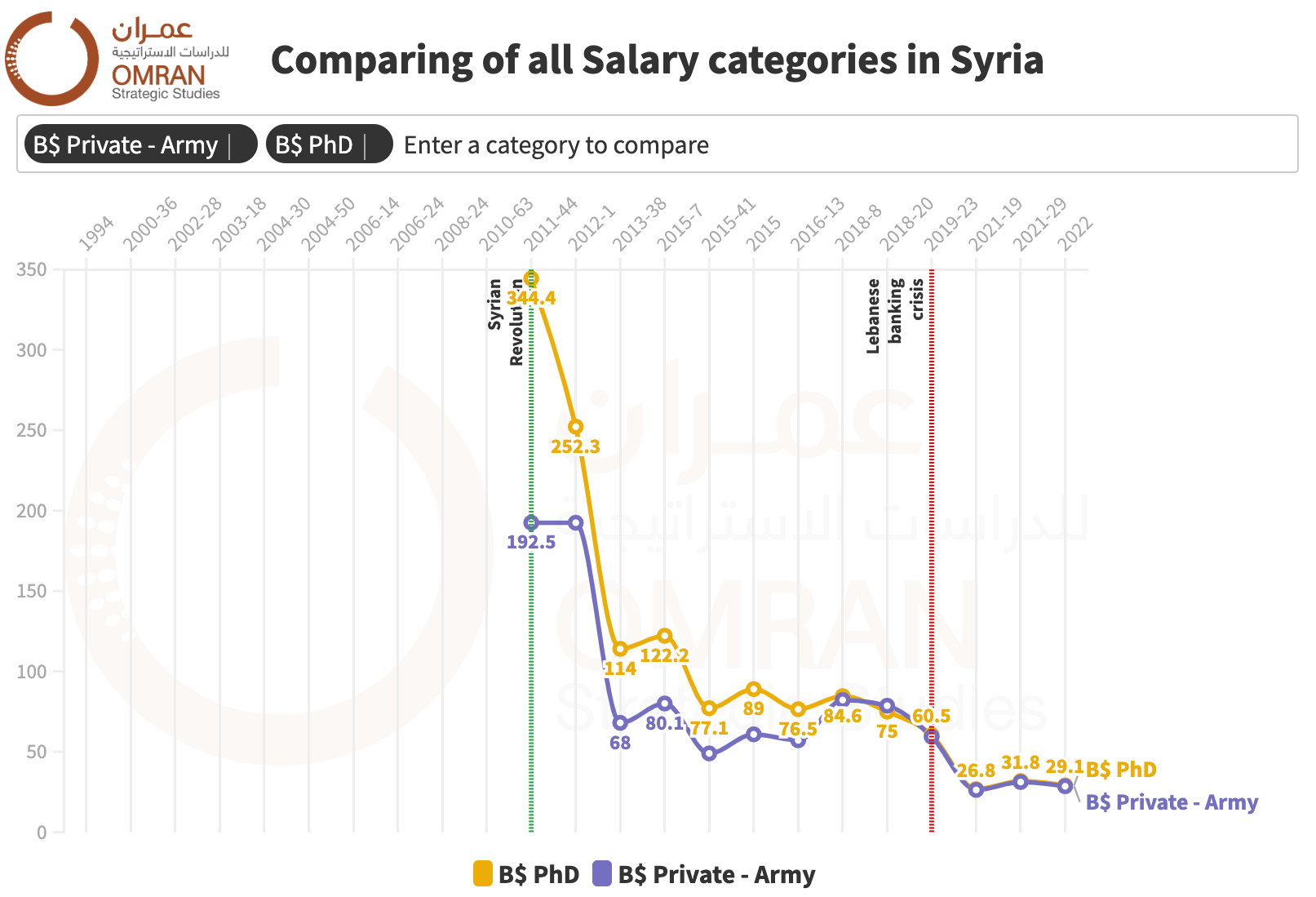
Figure (3): Salaries are denominated in dollars according to the black market
Note:The following interactive Chart provides comparisons between the different salary categories, with each other, and with the Syrian pound and the US dollar
Income: Tax collection and Military Exemption
The income tax law has undergone several amendments since Bashar al-Assad came to power. In 2001, he issued Legislative Decree No. 8 exempting the first 1,000 SP of the monthly salary from income tax. Later, the first 5,000 SP of the salary was exempt from income tax under the new income tax law No. 24 of 2003. The income tax law was be amended several times, the most recent of which was Legislative Decree 24 of 2020(17), which included an exemption of the first 50000sp of the salary from income tax by amending Articles 68 and 69 and abolishing Legislative Decree 46 and 48 of 2015.
The main point here is that the income tax law exempted, in Article 67, “military personnel of the armed forces, members of the internal security forces and firefighting personnel,” in addition to other categories, from income tax. This was not applied to public and private sector employees. Legislative Decree No. 18 of 2003, which includes the Article 81 of the Military Service Law, confirmed that military personnel benefit from a set of exemptions, including exemption from income taxes and various compensations and allowances. Legislative Decree No. 1 of 2012, which includes Article 155 of the Internal Security Forces Service Law, gave the Internal Security Forces the same exemptions granted to army soldiers. Thus, if the starting gross salaries of both a Ph.D holder and the lowest ranking soldier in the army are compared before and after-tax deductions, we find that the net salary of the soldier is greater than the net salary of a Ph.D holder(18): 
Salary Increases and the cost of the cost of Living According to cost of living
figures in Syria provided by the "Kassioun Index" consistently for many years, current salaries do not cover the expenses for three days of living(19). The cost-of-living index in September 2022 for a Syrian family consisting of five members reached 3.6 million SP,This is an unprecedented rise during a record period that threatened millions of Syrians who live in a catastrophic widening gap between the cost of living and the minimum salary for an entry - level public employee.The biginning monthly salary scale remains at the threshold of 92,970 SP (less than half the cost of the minimum monthly nutrition needs per worker alone)(20).This economic reality has left 90% of Syria’s population living below the poverty line; many of them forced to make very difficult choices to cover their expenses(21)The cost of living over the years compared with the minimum salary is illustraated the following figure:
Conclusion
Public sector employees do not depend solely on their salaries, which are barely sufficient to cover the cost of living for several days. Instead, they depend on various sources of income, such as financial transfers coming from abroad, or having a second job in the private sector. In addition, their supplemental income may be sourced in illegal forms of income as a result of financial corruption and bribery in government offices and institutions. As for the military, despite their salary increases, they have alternative sources of income, all of which are illegal; through looting, extortion, racketeering, and checkpoint taxes; Additionally, financial corruption related to purchases, contracts, and tenders of the Ministry of Defense that are supervised by procurement committees in military units are carried out in an exclusive manner only benefiting specific groups of officers and non-commissioned officers.
The foregoing is nothing but a natural product of a dictatorial state that puts all its resources at the service of its own military machine. It does not work to create a well-developed civilian state. It is a product of a country torn by war waged by the regime against the Syrian people. The regim's salary increase policy can be summarized as follows:
- A policy that incentivize the militarization of society and the transformation of military duty into a profession like any other profession. This was done through contracting with civilians or military personnel as mercenaries within the militias or sending mercenaries to areas of armed conflict under Russian supervision.
- Creating a repellent unstable environment:
- The policy led to increased migration waves , especially by educated classes, because even those who have higher degrees in the public sector are unable to make more money than the starting salary of the lowest grade military personnel that has an elementary school education. The regime’s message to young people is, “Don’t learn, go and work in the army.”
- The regime’s policy also aimed to send young people abroad in order for them to send remittances to their families later. Thus, the regime benefits from the foreign exchange transferred to the areas under their control in addition to these young people paying huge sums of money in order to be exempt from compulsory or reserve military service, which costs each person 5-10 thousand dollars as a fee according to the type of military service and the duration of their stay outside the country.
This policy is a warning to countries hosting refugees, given that returning them to regions controlled by the regime, while taking their safety into account, will force the majority of them into the predetermined fate of “engaging” in the military institution or joining an armed militia. The reality is that working in such jobs in the military sector is the only promising career option for young Syrians in regime-controlled areas.
Appendix: Salary Scale in Syria
The following is the salary scale for civilians, military personnel, and internal security forces, starting from the last increase during era of Hafez al-Assad in 1994 until 2022:
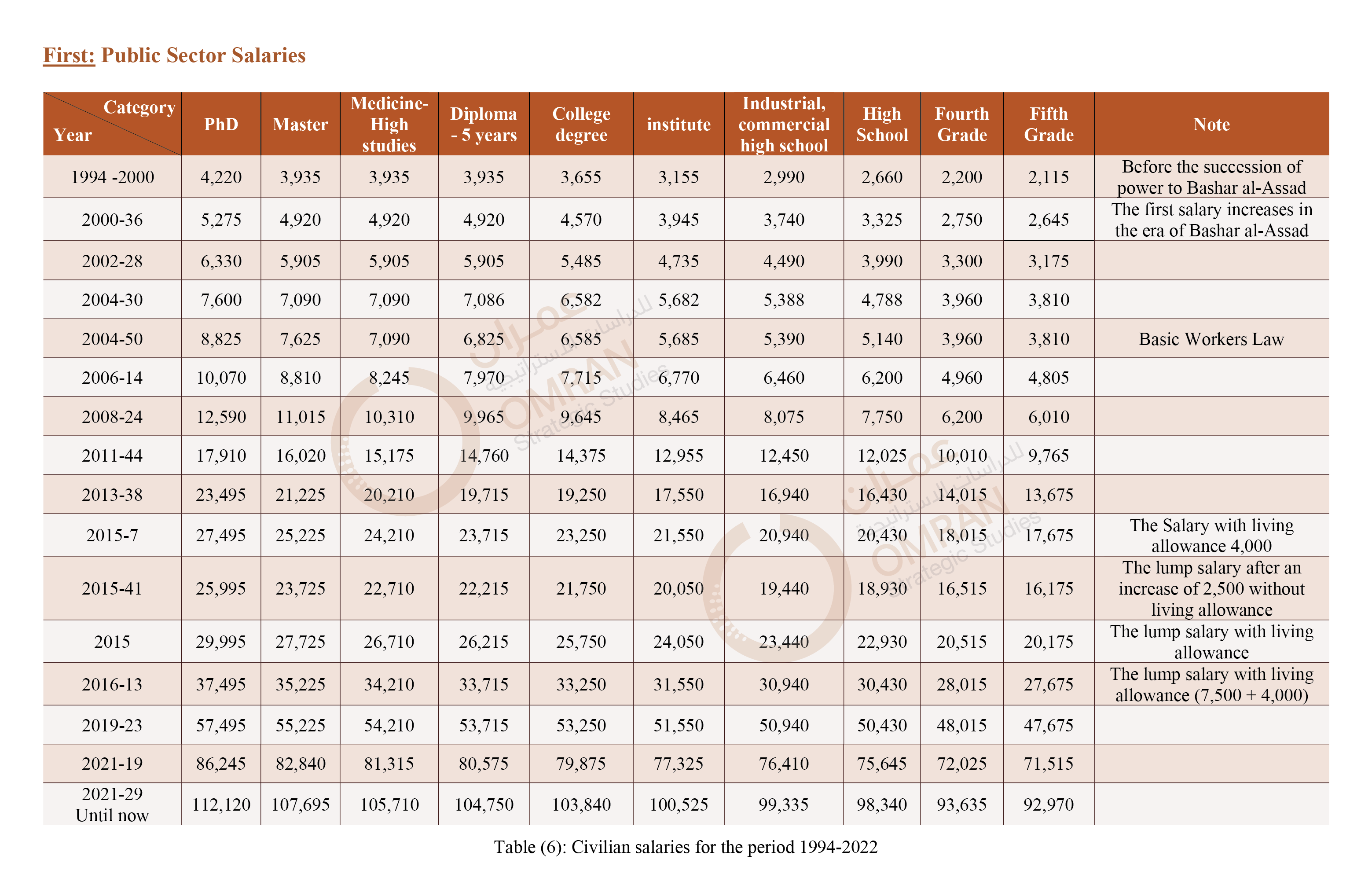

2- Salaries of Non-commissioned Officers and Individuals
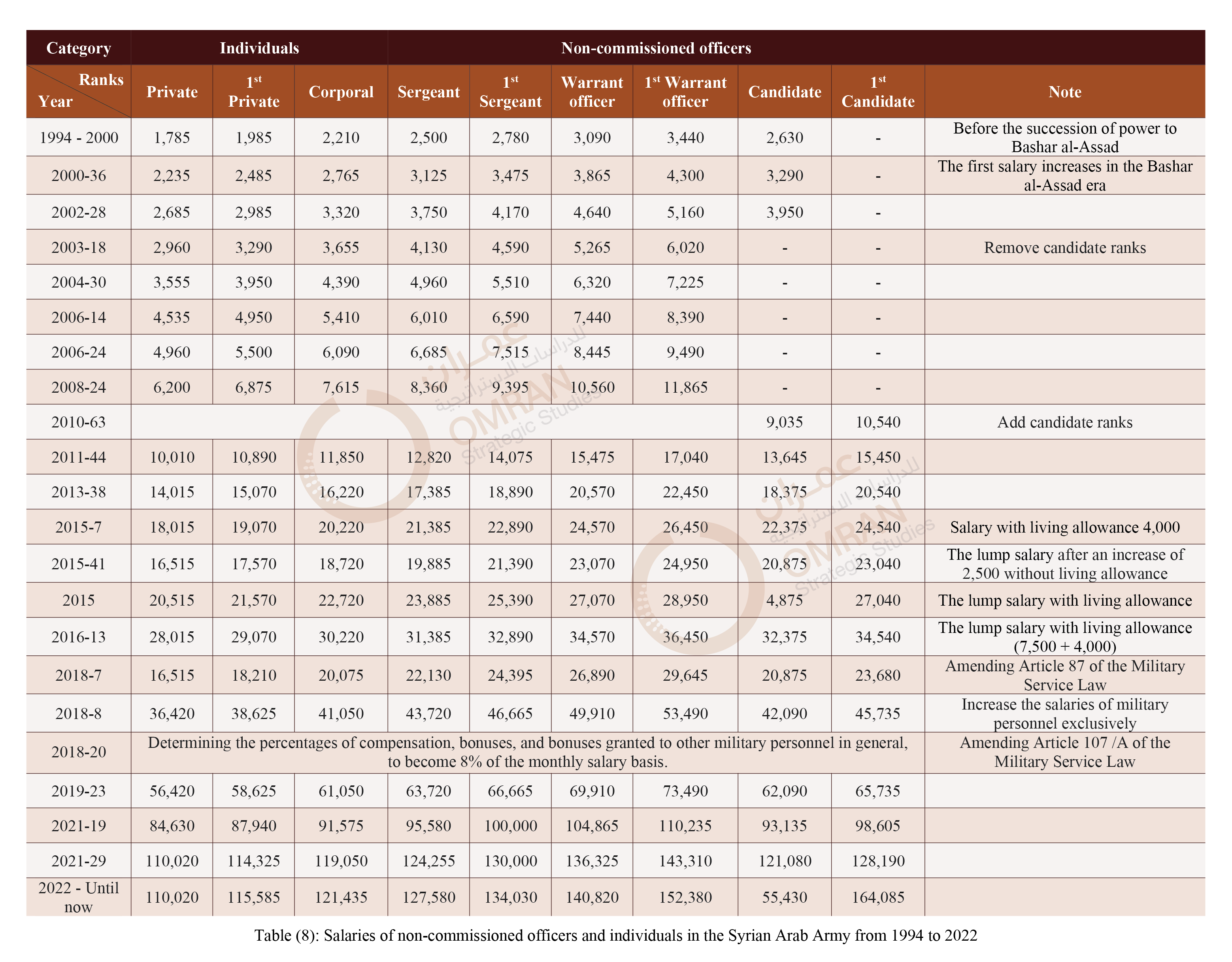
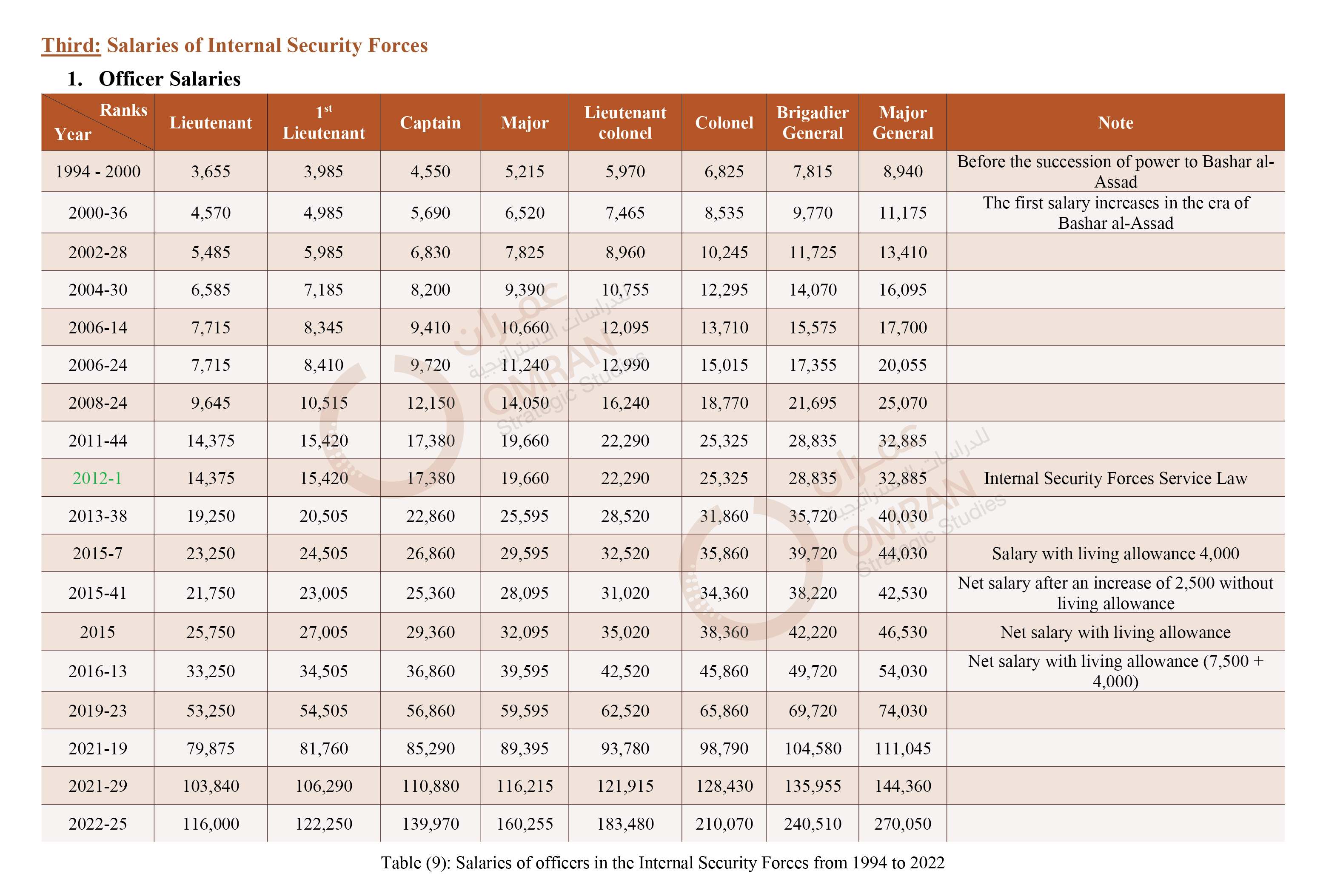
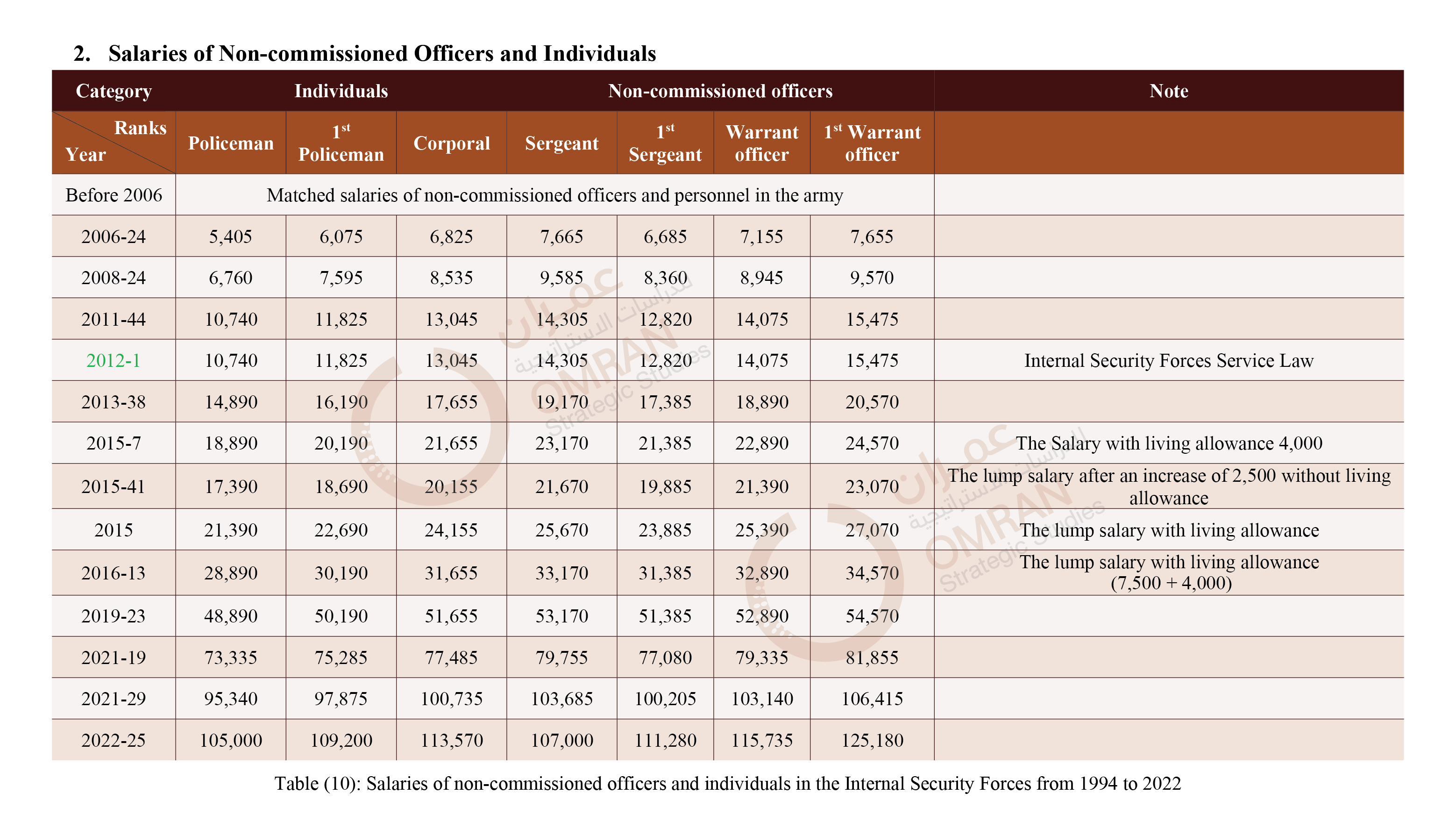
Note:
- During the translation of this paper into English and after the publication of the Arabic version of this paper in mid-November, Bashar al Assad issued Legislative Decree 25 of 2022 on December 27, 2022, that includes an increase in the salaries of the Internal Security Forces (police). This modification is included in the English version only.
- From mid-November to the end of December, the ex-change rate of the Syrian Pound was dropped from 5,200 to 7,300 SP against the US dollar.
Exchange Rates Between Official and Black Market
The exchange rates against the dollar were almost constant before 2011. Later, they began to vary with the passage of time, and a real difference began to appear between the exchange rate of Pound, according to the central bank, and the black-market rate. The Syrian Pound has lost its value against the dollar exponentially since 2011, and this has negatively affected the purchasing power, in addition to the increase in inflation rates. It is noted that the gap between the exchange rate of the Pound according to the central bank and the black market is relatively increasing steadily(26). The following are the exchange rates of the Pound against the dollar on the date of the issuance of the legislative decree to increase salaries.
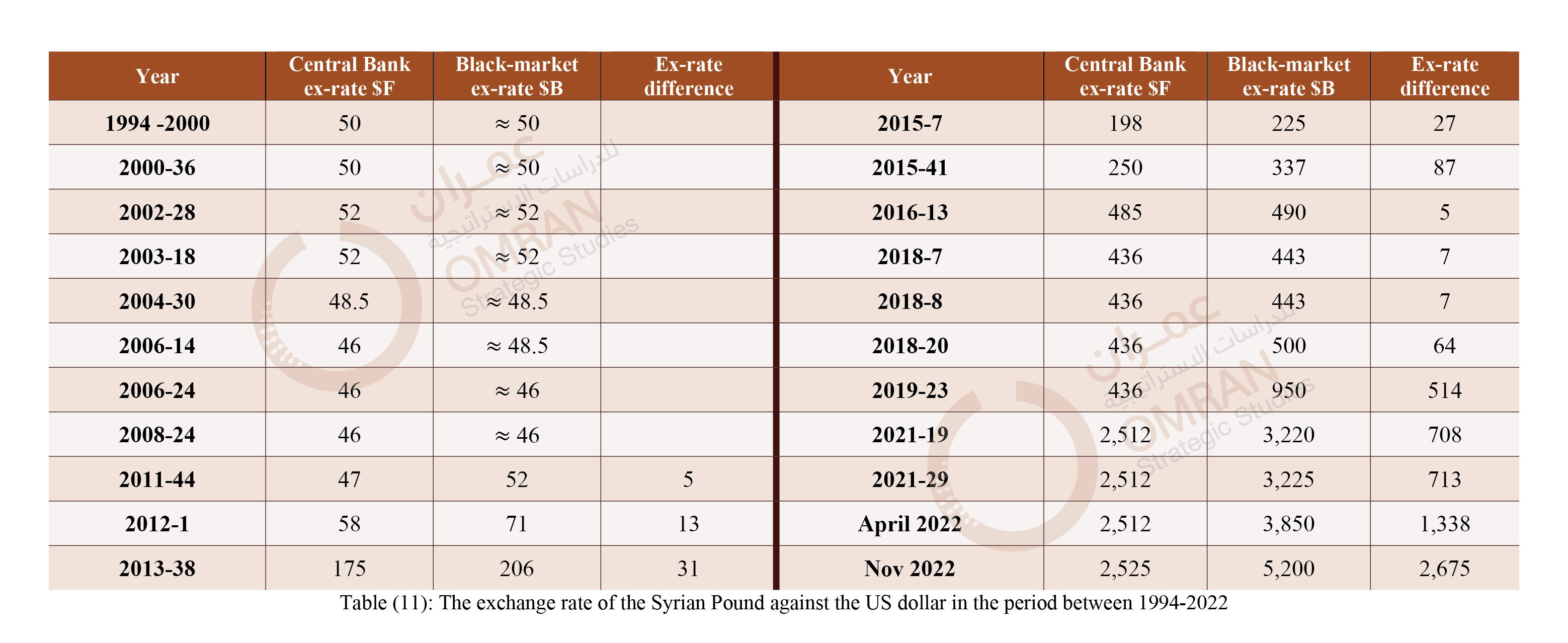
(1) “Law 50 of 2004, the basic system for workers in the state”, Syrian parliament, date of publication: 06 December 2004, date of access: 20/10/2022, link: https://bit.ly/3hqpqbF.
(2) “Legislative Decree No. 18 of 2003, Military Service Law”, Syrian parliament, published: April 21, 2003, Accessed: 14/01/2022, Link: https://bit.ly/3GyL0Cq.
(3) “Legislative Decree 1 of 2012, Internal Security Forces Service Law”, Syrian parliament, date of publication: January 2, 2012, date of access 16/05/2022, link: https://bit.ly/3lbG5hA.
(4) One of the mathematical equations used to calculate salaries after Legislative Decree 44 of 2011: where (J7) refers to the salary value in 2008: =CEILING(IF((J7+1500)>10000;((((J7+1500)-10000) * 20%)+(10000*30%))+(J7+1500);((J7+1500)* 30% +(J7+1500)));5)
(5) Ali Kanaan, “Stagnation in Syria”, Mafhum website, link: https://bit.ly/3Cocmdu.
(6) Legislative Decree 3 of 1994 issued on 30/4/2000, which includes granting an increase of 30% from the monthly lump sum salary or wage to the lump sum monthly salaries and wages for both civil and military workers in the state.
(7) Legislative decrees do not include increases in pensions.
(8)“Aviation salary” is an additional salary allocated to pilot officers, added to the lump sum salary and not considered part of it. It was mentioned in Article 87 of the Military Service Law, Ibid.
(9)The amount of 8% granted to the military is not an increase on the basic salary, but rather a determination of the number of allowances, bonuses and rewards on the basis of the monthly salary, and it constituted a mistake in this regard when it was published.
(10) Ali Kanaan, Ibid.
(11)The name of the ministry changed several times after 2000.
(12)The prices of basic materials that coincided with the increase in salaries were monitored, without tracking all the increases in the prices of those materials that were constantly rising without there being an increase in salaries.
(13 ) Muhsen AlMustafa: “The Comparison between Militias and the Army: Indicators of an Increase in Mercenaries,” Omran Center for Strategic Studies, publication date: October 06, 2022, access date: 20/10/2022, link: https://bit.ly/3DiG3gy.
(14) The rank of soldier in the army is granted to those who volunteered based on a basic education certificate.
(15 ) The interactive tool included on the website enables the user (reader) to carry out the comparisons he wants for all military classes and ranks in the appropriate manner.
(16 )The exchange rate according to the central bank is indicated by $F, while the exchange rate according to the black-market is indicated by $B.
(17) Article 68:
A: The tax rate, including national defense additions, school fees, the municipality’s share, and the cash contribution to support sustainable development, is determined as follows:
| 4 % of the part of the monthly net income that falls between the exempted minimum and 80,000 SYP. | 12 % of the part of the monthly net income between 170,001 and 200,000 SYP. |
| 6 % of the part of the monthly net income between 80,001 and 110,000 SYP. | 14 % of the part of the monthly net income between 200,001 and 230,000 SYP. |
| 8 % of the part of the monthly net income between 110,001 and 140,000 SYP. | 16 % of the part of the monthly net income between 230,001 and 260,000 SYP. |
| 10 % of the part of the monthly net income between 140,001 and 170,000 SYP. | 18 % of the part of the monthly net income that exceeds 260,000 SYP. |
B: The tax rate is set at 10% for each gross payment.
Article 69: A tax-exempt minimum of 50,000 SP per month shall be deducted from the net income.
(18 ) Compensations and bonuses were not calculated for both categories, given that the focus is on gross salaries and income tax.
(19 ) Kassioun Index: A cost-of-living index issued periodically by Kassioun magazine affiliated with the Popular Will Party headquartered in Damascus.
(20 ) “3.5 million, the average cost of living for the Syrian family at the gates of winter,” Kassioun Magazine, date of publication: September 26, 2022, access date: 1/10/2022, link: https://bit.ly/3fN2SBl.
(21) “Griffiths to the Security Council: 90% of Syrians live below the poverty line,” Al-Jazeera Net, date of publication: October 28, 2021, date of access: 25/03/2022, link: https://bit.ly/3RUnLaK.
(22 ) The salaries of the army include the salaries of the first grades only, as each rank has a salary grade to which the military personal is promoted while he remains in the rank for a certain period.
(23) Hidden increase for the military.
Syria along
Early Economic Recovery in NE Syria in the First Half of 2022
Executive Summary
- During the first half of 2022, 358 projects were implemented in Northeast Syria region. The water and sanitation sector topped the list with 148 projects, followed by transportation 77 projects, electricity 51 projects, social services 34 projects, trade 23 projects, and agriculture and livestock 18 projects. The distribution of the projects according to the administrative districts included the following: al-Jazeera Region 118 projects, Deir ez-Zor Region 96 projects, Raqqa Region 58 projects, Tabqa Region 41 projects, the Euphrates Region 29 projects, and Manbij Region 19 projects.
- Several administrative decisions by local authorities were issued during the monitoring period of this report. This included a decision banning the transport of wheat within the Autonomous Administration's regions without an official authorization letter issued by the “Administration”, fixing wheat prices at 2.200 SYP/Kg, limiting the quantity of diesel allocated per household to 300 liters/month at a price of 150 SYP/liter, and granting 100,000 SYP to every public employee in the region.
- The areas under the control of the Autonomous Administration suffer from severe crises in all sectors, which has led to the increase of monopolies, spread of corruption, and lack of a defensive ability to address crises imported from the regime's areas. This indicates a structural deficiency in the socio-economic model adopted and a governance inefficiency of the concerned institutions(1)
I. Methodology
The Autonomous Administration region of North and East Syria (AANES) encompasses parts of the governorates of Hasaka, Raqqa, and Deir ez-Zor. It extends over 50.000 square kilometers and hosts approximately 3.2 million inhabitants.
Under the Charter of Social Contract adopted by the AANES, the region consists of seven self-governing sub-regions: al-Jazeera, Deir ez-Zor, Raqqa, Tabqa, the Euphrates (al-Furat), Manbij, and Afrin.
The objective of the early economic recovery report is to provide a comprehensive analysis of the activities of municipalities as well as foreign and local organizations in the region during the first half of 2022. By compiling other recovery reports from the opposition and regime areas, the combined reports seek to assess and investigate the following:
- Activities and projects implemented, the development of local economies, and the comparison of regions and sectors.
- Levels of a safe working environment that governing entities and decision-makers can create to increase job opportunities, business and production operations, and local demand.
- Legislation and administrative decisions and their impact on the local economy.
This report attempts to monitor and analyze the implementation of economic and development projects in various sectors. Accordingly, it induces decision-makers to direct the support and fill gaps wisely. Based on the updated administrative division of the region and according to the International Standard Industrial Classification, the report focused on main cities and towns with notable economic activity.
The report represents actual activities that took place based on public source information available as well as individual interviews conducted by field staff. It does not claim to reflect all activities that took place but those that were announced publicly. It monitored and assessed data from official social media accounts of municipalities and organizations that operate in the area by documenting their activities and public periodic reports, and utilizing specified monitoring criteria that enabled data analysis based on sectoral and geographical classifications.
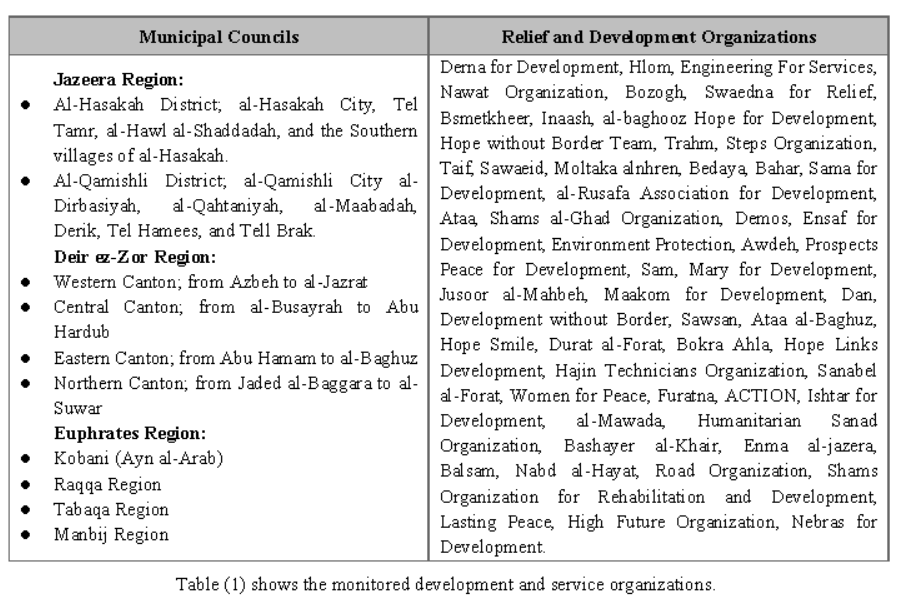
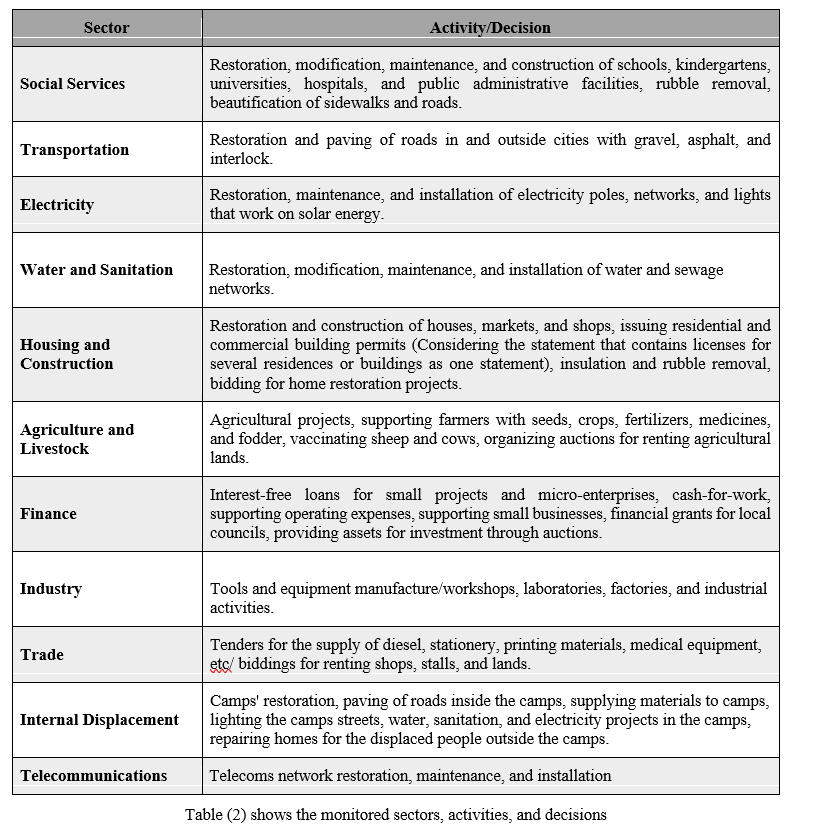
II. Economic Recovery Indicators: Weak Strategies & Will
As indicated in Figure (1), the number of projects implemented in the various districts of the AANES was 358. As for the distribution of projects’ percentages, the water and sanitation sector topped the list with 148 projects (40%), followed by the transportation sector with 77 projects (21%). The electricity sector was ranked three with 51 projects (14%), and the social services sector came in fourth place with 34 projects (9%), as shown in Figure (2).
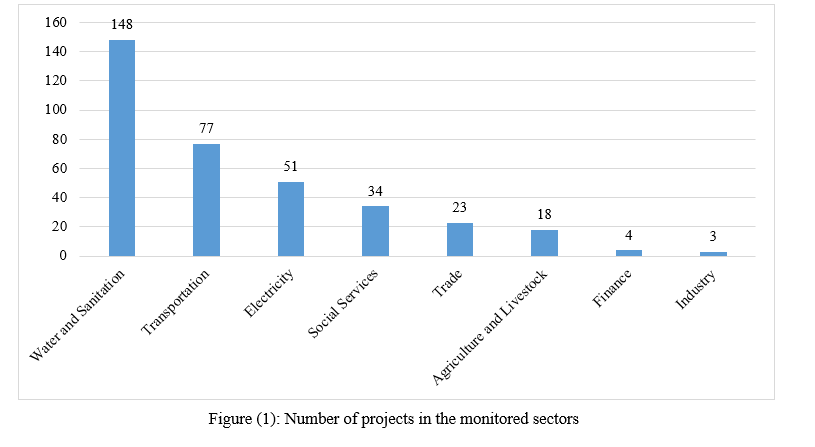
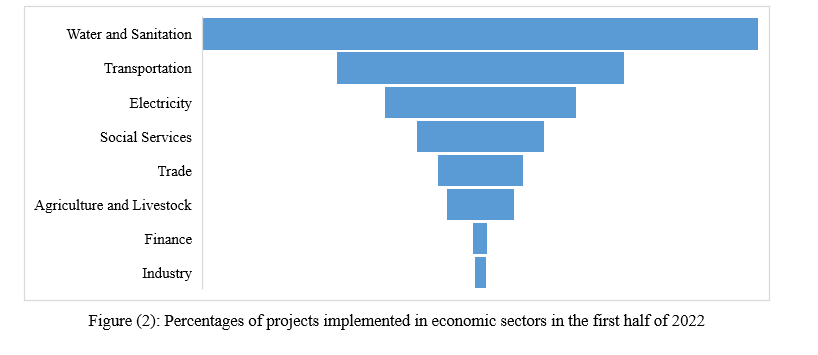
According to the geographical distribution of the monitored area, the largest percentage of projects was implemented in the al-Jazeera region 118 projects, followed by the Deir ez-Zor region 96 projects, Raqqa region 58 projects, Tabqa region 41 projects, Euphrates region 29 projects, and Manbij region 19 projects.

More specifically, Figure (4) displays the distribution of projects in the cities and towns monitored in all sectors. Markedly, Raqqa city ranked first with 58 projects, followed by the cities of al-Tabqa with 41 projects, Hajin with 34 projects, al-Qamishli with 26 projects, al-Busayrah with 23 projects, and Manbij with 19 projects.
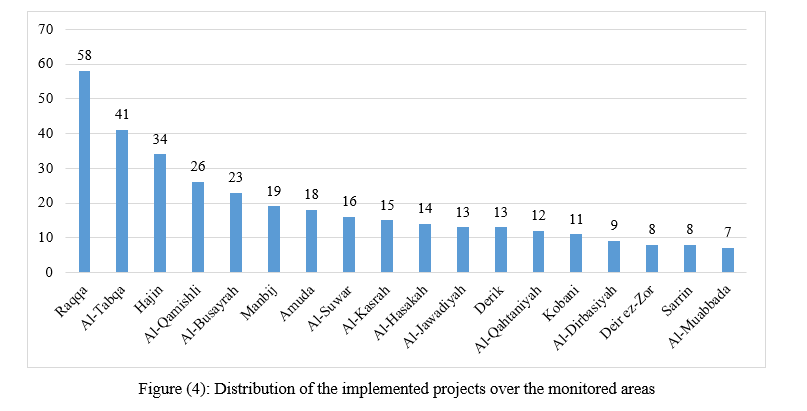 Water and Sanitation Sector
Water and Sanitation Sector
Out of 148 projects carried out, al-Tabqa city took the lead with 21 projects, followed by the cities of Hajin 18 projects and al-Busayrah14 projects, as shown in Figure (5). The projects included the installation of drinking water pipelines, with a length of 4000 meters, in the villages of Sarrin, Quroshan, and al-Murabba. There were also two other pipelines constructed: the first from the city of al-Busayrah to the reservoir of the village of al-Tukaihi (5,500 meters) and the second in the village of Abu al-Hassan (850 meters).
Other projects included expanding the water pipelines by 1150 meters in Hoti village, restoration of the water networks in the Kasra sub-district and al-Muhamida water station and establishing a new water station in al-Baghuz. However, the region suffers from several problems, the most significant of which is the lack of drinking water in the governorates of al-Hasakah, Deir ez-Zor, and Raqqa. For example, al-Hasakah city, which is inhabited by about a million people, suffers from constant water cuts caused by field disputes with the opposition factions in Ras al-Ayn, where Alouk water station operates.
The Alouk station delivers water to al-Hasakah at the rate of 60,000 m3/day, but the administration’s deliberate power cut disturbs its running. Russia has mediated between the two parties several times but all in vain. To compensate, the “administration” ran 16 desalination plants and transported water to homes through road tankers.
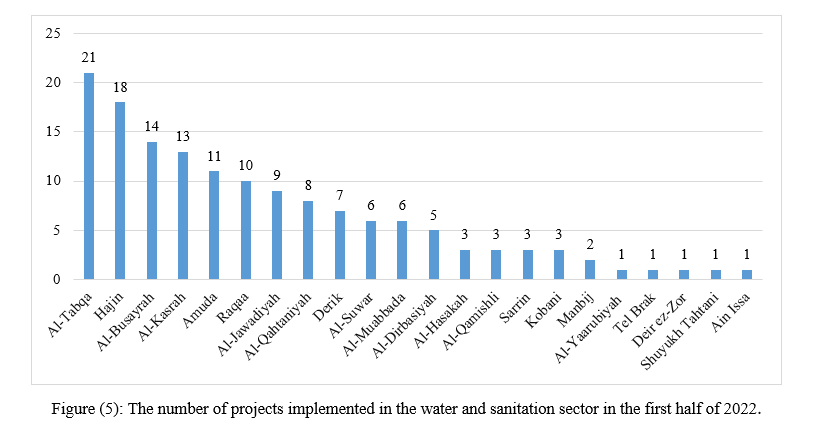 Transportation Sector
Transportation Sector
Seventy-seven projects were carried out in the transportation sector by municipalities and different organizations, with the cities of Manbij, al-Tabqa, Raqqa, and al-Qamishli taking the top four ranks, respectively. There were many projects of paving roads and restoration that took place in different locations of the monitored region, and here are some examples:
- Paving the highway between al-Hasakah and al-Dirbasiyah (20 km)
- Paving the road of the village of al-Jawadiyah in the Derik area of al-Qamishli (9 Km)
- Paving the roads of the Corniche, al-Hilaliyah, and the Western neighborhood
- Paving the road of al-Suwar city (10 km) and the restoration of its bridge
- Paving the street of Abu Hardoub in al-Busayrah
- Paving the road connecting the village of Taan and al-Sayed, Tel Houdan road (500 meters), Shajif Zahabieh village road (12450 meters), and al-Fars Abu Qalqal road (8300 meters) in Manbij.
- Road restorations in the neighborhoods of al-Sabbahiya, al-Tayyar, al-Jazeera, and al-Rumaila in Raqqa
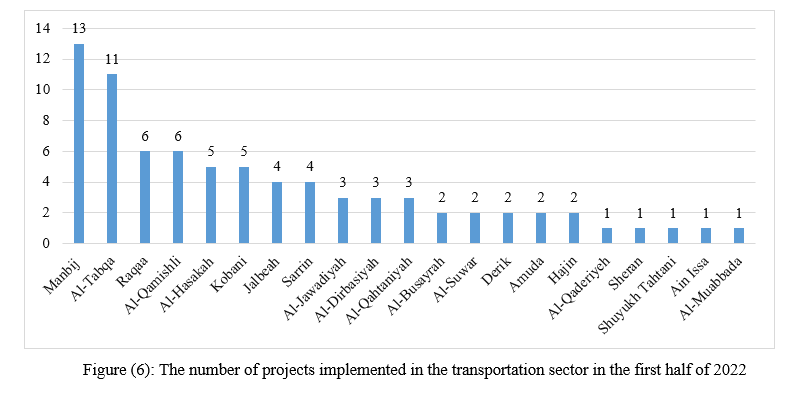 Electricity Sector
Electricity Sector
Fifty-one projects were implemented in the electricity sector, with al-Qamishli, Raqqa, and Hajin in the top three positions.
The works carried out varied to include the following:
- Installing a power transformer, five towers, and 13 wooden poles in Kobani
- Installing street lighting at the northern and southern entrances in Sarrin
- Installing street lighting in the towns and cities of al-Shaitat, al-Shaafa, Hajin, al-Baghouz, al-Suwar, Muhaimidah, al-Malahi, and the city of Raqqa
- Completing the project of the 7000 meters of lighting in the al-Nasrah neighborhood in al-Hasakah
- Installing 40 solar panels and four poles in several places in the city of al-Qamishli
- Installing new power transformers of 400 KVA and other ones with different capacities in many neighborhoods and villages
Nevertheless, people suffer from a chronic electricity shortage. In fact, they depend on the amperes, as the AANES provides diesel at a reduced price for neighborhood generators at 85 SYP per liter instead of 410 SYP.
The situation was exacerbated in al-Qamishli, with the “Administration” cutting off diesel from the generators that provide homes with electricity. In addition, many factories, industrial and commercial projects, and bakeries became out of work because the “Administration” blocked the diesel allocations assigned to the industrial and commercial sectors.
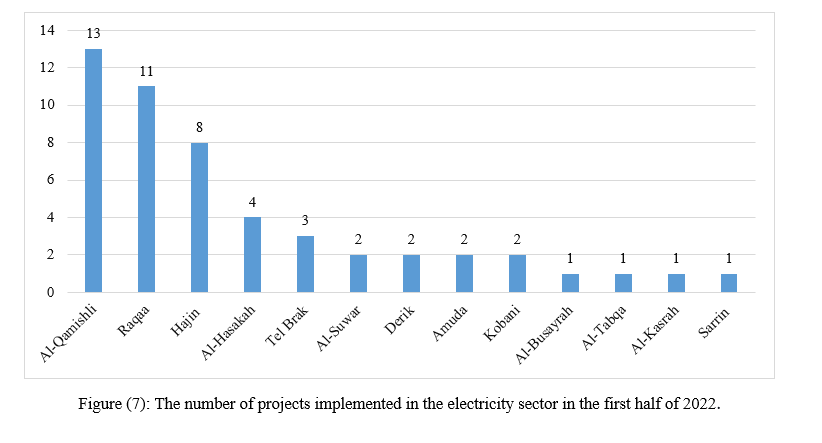 Social Service Sector
Social Service Sector
34 projects were implemented in al-Tabqa, Deir ez-Zor, and al-Busayrah, including rubble removal for the cities' streets. Other projects were also completed in the monitored towns and villages and included the following:
- Building al-Bayram School in Manbij
- Establishing an agricultural land reserve (12,000 m2) near the Borzi Dam
- Constructing a development center in al-Dirbasiyah at the cost of $4211
- Opening two new Newroz markets in the Western neighborhood of al-Qamishli
- Restoration of a number of municipalities such as al-Dahla, al-Za'bar, al-Hussein, Jadeed Ekedat, al-Keshkiyah, and al-Tabqa
Although the AANES’s vision is to serve the interests of society by establishing economic institutions that are social in nature, the number of projects in this sector does not correspond to its stated goal.
 Trade Sector
Trade Sector
In the trade sector, 23 projects were implemented, with Raqqa coming in first with 15 projects. Other cities such as Hajin, al-Tabqa, Deir ez-Zor, and Manbij were also included in the list.
The projects included several commercial and economic activities and were as follows:
- Requesting price quotations for renting vehicles such as vans, tractors, and dump trucks
- Launching auctions for selling scrap iron and used oil
- Launching auctions for investing in the commercial market in al-Tabqa and shops filling in the al-Thakna neighborhood in Raqqa
- Conducting tenders to supply materials to the Public Works Department in Raqqa and Manbij
The difficulties in the trade sector are evident in the “AANES” areas with the closure of the border crossings with Turkey and the problems of securing locally made products that meet people's needs. Still, Turkish and Iranian goods are spread in the region through the Semalka crossing. The economic ramifications are enormous, especially with the increased monopoly of goods by the war's new elites and smugglers affiliated with the Kurdistan Regional Government of Iraq.
 Agriculture and Livestock
Agriculture and Livestock
The agriculture and livestock sector had its share of the development plan, with a total of 18 projects completed. Deir ez-Zor came first with four, followed by al-Busayrah, al-Suwar, and al-Qamishli, with two projects each. The most important projects were establishing two farms of cypress and pine trees in the Mazkaft Dam Reserve, planting 3000 trees in each one, and supporting the camel, poultry, and livestock ranchers.
Until July, the Economics and Agriculture Board reported receiving about 360 thousand tons of wheat in Northeastern Syria and distributed 647,000 tons of fertilizer to farmers in Amuda.
During 2020-2021, landowners and farmers experienced great losses due to the high costs of fuel and fertilizers, drought, and high production costs. The corruption in the agricultural sector is linked to the illegal access that some individuals in the “Administration” have to subsidized water and farming materials, which forced many farmers to give up their lands to those with the most influence.
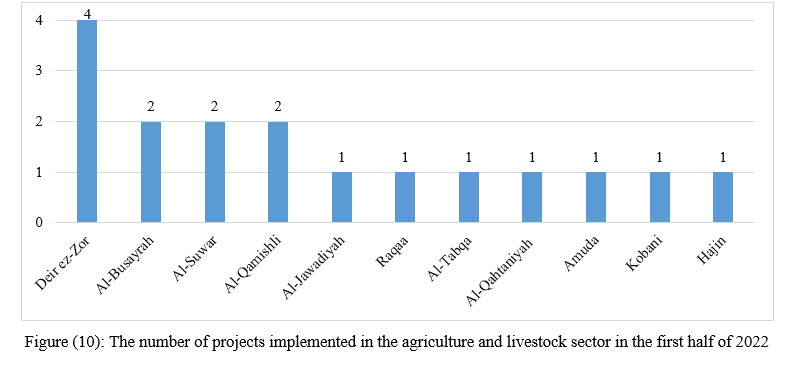 Finance Sector
Finance Sector
Four projects took place in al-Busayrah, Raqqa, and Deir ez-Zor. Supporting small and medium-sized enterprises and people with special needs.
And lastly 3 projects took place in the Industrial sector which are:
- Constructing a hose factory in al-Tabqa
- Starting a filling oxygen cylinders unit for hospitals and dispensaries in al-Qamishli
- Starting a plant for bottling drinking water in Amuda.
Administrative Decisions and Instructions
Several important decisions were made during the monitoring process including the following points:
- Preventing the wheat transfer within the administration's regions except by an official letter
- Setting the prices of wheat at 2.200 SYP/Kg, the ice block at 2000 SYP.
- Setting the price of an ampere of electricity by generators at 4000 SYP for subscribers of 6 amperes or less— generators running time is from 4 pm to 12 pm
- Adjusting the price of Russian phosphate fertilizer to $700/ton and nitrogen fertilizer to $730/ton by the Agricultural Society Development Company
- Obliging drivers to abide by the price set at 300 SYP within al-Qamishli
- Granting 100,000 SYP to every employee in the “Administration”
- Suspending the allocations of al-Baghouz and al-Shaab bakeries due to complaints
- Establishing a 25,000 SYP fine for anyone who violates the public hygiene rules (the Directorate of Environment in the al-Jazeera region)
- Specifying the amount of household diesel at 300 liters per month/ 150 SYP per liter (the Fuel Committee)
III. Concluding Analysis: Structural Inadequacy
The monitoring of the AANES region during the first half of 2022 indicated the following:
- Despite the completion of 358 projects in total and 148 projects in the water and sanitation sector, there is still an intractable crisis in ensuring drinking water to the residents of al-Hasakah city, with the lack of agreement or arrangements with the opposition factions in Ras al-Ayn.
- The decision to set a subsidized price only for registered cars encouraged the activity of the black market in which fuels are priced at five to ten times the regular market rate. Also, signing the oil refining and supply contracts with ‘specific people’ created a state of monopoly that had a negative impact on all sectors and citizens.
- The electricity sector suffers from crises that have forced people to rely on generators and amperes, not to mention the administration's unjustified cutting of the diesel supply.
- In the trade sector, the war elites and the influential people's control over the import and distribution of building materials may, over time, weaken the commercial structure and spread corruption.
- As for the agricultural sector, the weakness is apparent due to the lack of support for farmers and livestock ranchers, the spread of nepotism, and the intervention in distributing subsidized materials. It is noteworthy that the AANES region enjoys the most important strategic crops, such as wheat and cotton, and covers 43% of the total arable land of Syria (except for the Ayn al-Arab region).
- The administration's lack of financial defenses against crises imported from the regime's area, such as inflation, indicates weak governance in the financial sector and economic management. The absence of indicators and economic data was also one of the challenges that faced the monitoring and forecasting processes.
Based on the analyzed data, it can be concluded that the quality and the size of implemented projects and works in the AANES region indicate a structural inadequacy in the socio-economic model followed. Moreover, the AANES's various institutions and offices dealing with economic affairs did not contribute to the region's recovery or stability— despite controlling approximately 55% of the resources of Syria's GDP.
([1]) Original paper published on October 20, 2022, in Arabic,https://bit.ly/3T4S7IS
Early Economic Recovery in Opposition Controlled Areas between 2018 -2022
Introduction and Methodology
Early economic recovery aims to support local communities in returning to a stable and normal life, including preventing the community from returning to violence. The Early Recovery Report monitors projects implemented over a period of six months and is issued semi-annually, focusing on the main cities and towns in the "Euphrates Shield","Afrin" and Idlib governorate, which is witnessing remarkable economic activity, within 11 sectors which are: social services, transportation, electricity, water and sanitation, housing and construction, agriculture and livestock, finance, industry, trade, internal displacement, and communications.
The report relied on the official identifiers of local councils and organizations operating on Facebook and Telegram. The data was analyzed according to two levels, the first at the level of economic sectors, and the second by geographical level. Among the monitored areas in the countryside of Aleppo: Marea, A'zaz, al-Bab, Jarabulus, Akhtarin, Qabasin, Bza'a, Afrin, and Al Atarib. In Idlib Governorate: Idlib, Harem, Sarmada, Ma'arrat Misrin, Hazano, Salqin, Armanaz, Termanin, Atme, Al-Dana, Kah, Deir Hassan.
The report aims to analysis and understand the following:
- Monitor the dynamics of the activities and works carried out in the region, thus measuring the development of local economies, and comparing regions and sectors with each other.
- Exploring the ability of local and international actors to create a safe environment for living and working, and the ability of local councils to play a governance role and sign memoranda of understanding with companies and organizations that contribute to providing with the necessary projects.
Distribution of Projects According to Sectors
Overall, 5,024 projects were implemented in the countryside of Aleppo and Idlib between 2018 to 2022 through eleven economic sectors. The number of projects rose slowly with 338 projects in the second half of 2018 to 954 projects in the first half 2022 as shown in Figure No. (1) below.
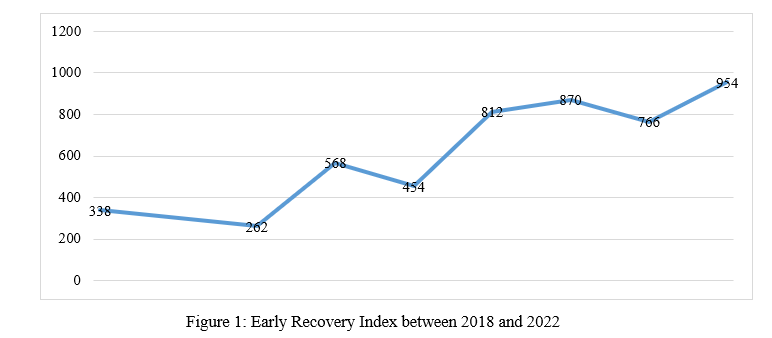
The highest percentage of projects were implemented in the transportation sector compared to the other sectors, as shown in Figure No. (2). These projects mainly contributed to the restoration of main and secondary roads destroyed by the war. These roads were vital to connecting villages and cities and facilitating civilian movement and trade. Water, sanitation, and trade projects came in second and third with 17% each, and the internal displacement sector ranked fourth at 13%.
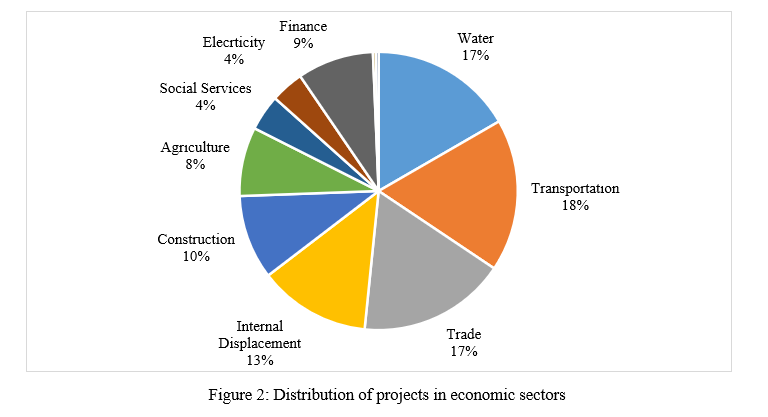
In more detail, Table No. (1) shows the sectoral survey on recovery projects during the observed period, where 891 projects were implemented in the transportation sector, 865 projects in the trade sector, followed by the water and sanitation sector with 837 projects. These projects were central to the recovery process in the region as they extended new water and sewage networks, repaired old networks, performed periodic maintenance, and repaired faults if they occur, such as paving roads, sidewalks, and commercial markets with asphalt and stone. Although these projects are still referred to as relief, they supported 1,293 camps, with a massive number of internally displaced persons, to access support and services. Projects related to construction were relatively low, around 487 projects were implemented, that included residential complexes for those displaced and the issuing of licenses for commercial and residential buildings. Agriculture projects were also lower, as farmers are reluctant to farm, there were only 403 projects during the observed period. The industrial, communications, and finance sectors are also suffering at the bottom of the index, due to the security situation and lack of investment in the region.
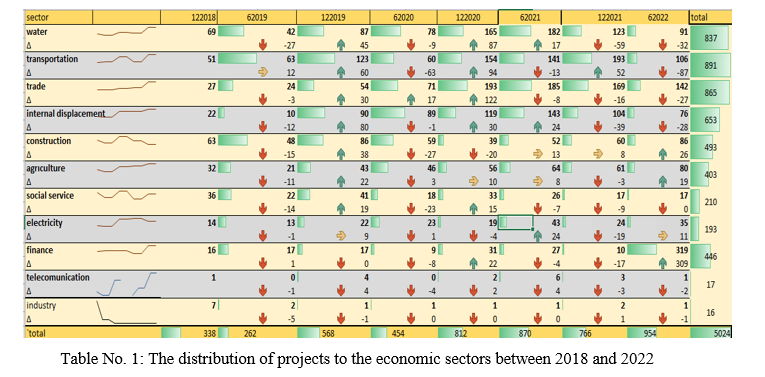
Distribution of Projects According to Regions
Figure No. 3 shows the distribution of projects between the countryside of Aleppo and Idlib between 2018 and 2022. The countryside of Aleppo had the largest percentage of projects with 55% about 2,757 projects were implemented in many towns and cities, most notably Azaz, Al-Bab, Afrin, Jarablus, Qabasin, Bza’a, Marea and others. The remaining 2,267 were executed in Idlib, Sarmada, Dana, Atma, Harem and others in Idlib governence.
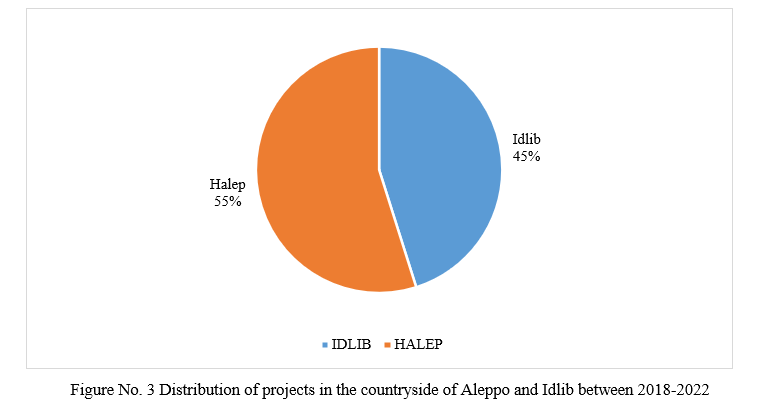
Table No. 2 shows the detailed distribution of projects at the level of towns and cities, where the city of Idlib appears at the top of the index with 669 projects, most of them in the sectors of internal displacement and trade. The city of Al-Bab, in the countryside of Aleppo ranked second with 598 projects in the sectors of housing, construction, trade, water and sanitation, and then Azaz with 475 projects in the sectors of water, transport, and electricity. A number of factors contributed to the discrepancy in the number of projects in cities and towns, including population density, displaced people and organizations, the centrality and importance of some cities before the revolution, the location of towns and cities on trade lines or near crossings, security situation, and lastly the concentration capital in some cities more than others.
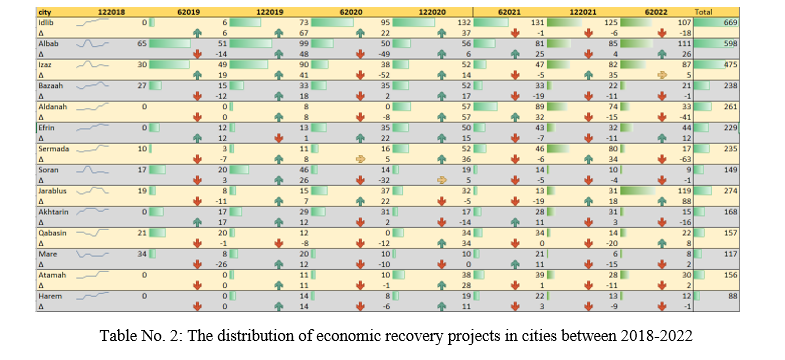
Recommendations
Local councils and organizations have implemented important projects that pushed the early economic recovery process forward. Indicators of stability are also more apparent than before. With over four years of monitoring economic recovery activities, reports have highlighted the strengthened national negotiation papers while contracting investment companies to bring in investments. Furthermore, the industry, agriculture, communications, and finance sectors remain a significant challenge in the region’s recovery and attracting funds and investments. This is due to the lack of policies and laws necessary to enhance confidence in the local economy and products, the shortage of raw materials, high prices of raw materials, and the decline in purchasing power, in addition to the fact that the region remains trapped in relief projects.
Among the report's recommendations is to support local councils with good governance policies and implementation within each sector. This would ensure and support workflow, helping them be more attractive for investments. Support in the financial sector would revitalize the other sectors and create a comprehensive identity for the region within the agricultural and industrial sectors. As a result employment oppoturnities would increase, thus supporting residents with more jobs and a sustainabile livelihood.
The Potential of the Syrian Diaspora in the US to Invest in Northwest Syria
Executive Summary([1])
Ömer Özkızılcık
19.09.2022
The US announced a sanction exemption for twelve economic areas in specific territories of Syria controlled by the YPG and the areas controlled by the Syrian Interim Government – except Afrin. Within the same time frame, the Turkish government announced its eight-step plan to facilitate the voluntary return of 1 million Syrian refugees back to Syria. As these two overlap, the Syrian diaspora and its financial capacity to invest in NW Syria provide an opportunity for a win-win-win situation for all. Based on the 2014 census, this report elaborates on the Syrian diaspora in the US and looks further into examples of investments by this diaspora in NW Syria. The paper took three different examples of donations, large infrastructure projects in telecommunication, and housing projects for IDPs to measure the potential of investments from the Syrian American community in NW Syria. The next part of the report about potential obstacles and solutions was based on information gathered from six online interviews with eleven persons with knowledge about the Syrian American community, their investment potential, their demands, and their fears. In this manner, the report finds out mainly four areas of potential obstacles: security, law, financial infrastructure, and trust:
Security:
· External security threats and internal security concerns could be tackled by establishing industrial and employment centers as well as housing sites outside of the 15km range from the frontlines
Law:
· Law enforcement and the impartiality of courts are of serious concern for potential investors and improvement of law enforcement as well as the judicial system is required to increase investment potential
Financial infrastructure:
· Financial infrastructure provided by PTT is regarded as insufficient by investors, creates bureaucratic hurdles, and can lead up to a 6-8% loss of the investment money. A mechanism to facilitate money transfer into Syria like establishing bank branches in Syria is needed.
Trust:
· To establish trust, investments should begin with investment projects with an average value of $100 thousand. Furthermore, partnership of investors with Turkish businessmen should be facilitated and the establishment of a joint board tasked with reaching out to potential investors and aiding them in their investments has to be formed. A new mechanism should be introduced that allows investors to visit Syria with fewer bureaucratic hurdles and less economic costs.
Depending on how much of these suggestions are implemented, the Syrian diaspora in the US is estimated to invest in NW Syria $100-750 million over the next five years.
([1]) Original paper published on September 13, 2022, in Turkish, https://bit.ly/3DziK3M
Executive Summary([1])
Ömer Özkızılcık
19.09.2022
The US announced a sanction exemption for twelve economic areas in specific territories of Syria controlled by the YPG and the areas controlled by the Syrian Interim Government – except Afrin. Within the same time frame, the Turkish government announced its eight-step plan to facilitate the voluntary return of 1 million Syrian refugees back to Syria. As these two overlap, the Syrian diaspora and its financial capacity to invest in NW Syria provide an opportunity for a win-win-win situation for all. Based on the 2014 census, this report elaborates on the Syrian diaspora in the US and looks further into examples of investments by this diaspora in NW Syria. The paper took three different examples of donations, large infrastructure projects in telecommunication, and housing projects for IDPs to measure the potential of investments from the Syrian American community in NW Syria. The next part of the report about potential obstacles and solutions was based on information gathered from six online interviews with eleven persons with knowledge about the Syrian American community, their investment potential, their demands, and their fears. In this manner, the report finds out mainly four areas of potential obstacles: security, law, financial infrastructure, and trust:
Security:
· External security threats and internal security concerns could be tackled by establishing industrial and employment centers as well as housing sites outside of the 15km range from the frontlines
Law:
· Law enforcement and the impartiality of courts are of serious concern for potential investors and improvement of law enforcement as well as the judicial system is required to increase investment potential
Financial infrastructure:
· Financial infrastructure provided by PTT is regarded as insufficient by investors, creates bureaucratic hurdles, and can lead up to a 6-8% loss of the investment money. A mechanism to facilitate money transfer into Syria like establishing bank branches in Syria is needed.
Trust:
· To establish trust, investments should begin with investment projects with an average value of $100 thousand. Furthermore, partnership of investors with Turkish businessmen should be facilitated and the establishment of a joint board tasked with reaching out to potential investors and aiding them in their investments has to be formed. A new mechanism should be introduced that allows investors to visit Syria with fewer bureaucratic hurdles and less economic costs.
Depending on how much of these suggestions are implemented, the Syrian diaspora in the US is estimated to invest in NW Syria $100-750 million over the next five years.
